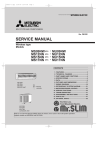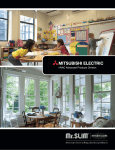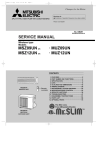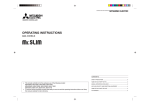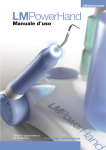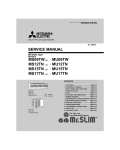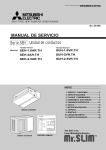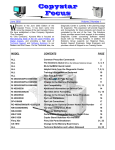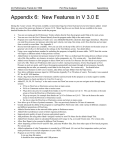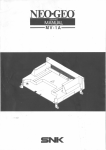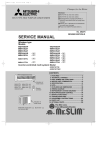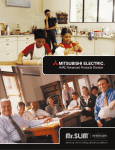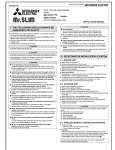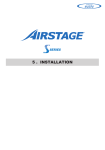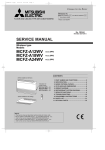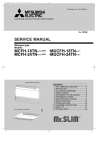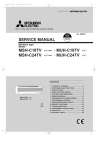Download Mitsubishi Electric MSH15NN Service manual
Transcript
OB198--1.qxp
24/6/97 5:56 AM
Page 1
SPLIT-TYPE, HEAT PUMP AIR CONDITIONERS
No. OB198
SERVICE MANUAL
Wireless type
Models
MSH09NW
MSH12NN
MSH15NN
MSH17NN
(WH)
(WH)
(WH)
(WH)
·
·
·
·
MUH09NW
MUH12NN
MUH15NN
MUH17NN
CONTENTS
MSH12NN
MSH15NN
MSH17NN
INDOOR UNIT
Remote
controller
1. FEATURES ·························································3
2. TECHNICAL CHANGE·······································4
3. PART NAMES AND FUNCTIONS······················4
4. SPECIFICATIONS ··············································6
5. DATA·································································10
6. OUTLINES AND DIMENSIONS ·······················23
7. WIRING DIAGRAM ··········································26
8. REFRIGERANT SYSTEM DIAGRAM ··············28
9. MICROPROCESSOR CONTROL ····················30
10. SERVICE FUNCTIONS·····································41
11. TROUBLESHOOTING ······································43
12. DISASSEMBLY INSTRUCTIONS·····················55
13. PARTS LIST······················································65
14. OPTIONAL PARTS···········································74
The Slim Line.
From Mitsubishi Electric.
MUH12NN
MUH15NN
OUTDOOR UNIT
L IS E D
T
R
OB198--1.qxp
24/6/97 5:56 AM
Page 2
OB198--1.qxp
24/6/97 5:56 AM
1
Page 3
FEATURES
MSH12NN, MSH15NN
Models
LCD wireless
remote controller
MUH12NN, MUH15NN
Cooling capacity
Heating Capacity
SEER
HSPF
MSH09NW
8,800Btu/h
10,500Btu/h
10.0
6.8
MSH12NN
12,900Btu/h
13,500Btu/h
10.2
6.8
MSH15NN
14,600Btu/h
14,800Btu/h
10.7
6.8
MSH17NN
16,200tu/h
17,200tu/h
10.3
6.8
NEW “I FEEL CONTROL” IN OUR LCD WIRELESS REMOTE CONTROLLER WITH ON/OFF PROGRAM
TIMER
Mitsubishi Electric’s new wireless remote controller incorporates a number of advanced features that provide even greater control and ease-to- use. It has a liquid crystal display which indicates such infomation as mode, fan speed and temperature
selected as well as the programmed ON/OFF time. It is also equipped with “I Feel Control”, a unique Mitsubishi Electric feature
that allows the user to adjust the temperature to exactly the level he or she wants simply by tapping the button that describes
present conditions : “Too Cool” or “Too Warm”. The optimum temperature set this way is then memorized for immediate recall
whenever the air conditioner is used again. And what’s more, the new controller has been made more better design and easier
to handle than even before.
Select desired air flow direction.
REMOTE-CONTROL OPERATION MODE
Using the remote controller, you can select from five airflow settings to match room layout and the location of people. Also, you
can set the vane to swing automatically.
SWING
Small in size, big on cooling.
COMPACT INDOOR UNIT
The sleek design of the NW/NN Series matches virtually any room
layout. For instance, MSH09NW is 1013/16 ✕ 321/16 ✕ 7 3/16
(H✕W✕D), which used to be 143/16 ✕ 311/8 ✕ 5 3/8.
1013/16
MSH09NW
AUTO-RESTART FUNCTION
The auto-restart function restarts the equipment when power is
restored following an outage automatically. Operation resumes in
the mode in which the equipment was running immediately before
the outage.
HIGH PERFORMANCE ROTARY COMPRESSOR
The advanced design of Mitsubishi Electric’s powerful and energyefficient rotary compressor results in lower operating costs and
longer service life.
3
OB198--1.qxp
2
24/6/97 5:56 AM
Page 4
TECHNICAL CHANGES
MSH09EW ➔ MSH09NW
1. Indoor unit has changed.
(Outline dimension changes. 31-1/8”o5-3/8”o14-3/16”(WoDoH)➔32-1/16”o7-3/16”o10-13/16”(WoDoH))
2. Outdoor unit has changed. (Capillary tube and refrigerant had changed.)
3. Remote controller has changed. (The timer function was changed to the clock timer function.)
4. Indoor auto vane has been adopted.
MSH12EN, MSH15EN ➔ MSH12NN, MSH15NN
1. Indoor unit has changed.
(Outline dimension changes. 39-3/8”o7”o14-3/16”(WoDoH)➔39-15/16”o7-1/2”o12-5/8”(WoDoH))
2. Outdoor unit has changed.
(Outline dimension changes. 33-1/2”o11-7/16”o23-7/8”(WoDoH)➔33-7/16”o11-7/16”o23-13/16”(WoDoH))
(Capillary tube, refrigerant and pipe had changed.)
3. Remote controller has changed. (The timer function was changed to the clock timer function.)
4. The swing mode was addedd to indoor auto vane.
MSH17NN
1. New Model
3
PART NAMES AND FUNCTIONS
MSH09NW, MSH12NN, MSH15NN, MSH17NN
REMOTE CONTROLLER
4
OB198--1.qxp
24/6/97 5:56 AM
Page 5
INDOOR UNIT
MSH09NW
MSH12NN
MSH15NN
MSH17NN
(When the front panel is opened)
MSH09NW
MSH12NN, MSH15NN,MSH17NN
MSH09NW
MSH12NN, MSH15NN,MSH17NN
OUTDOOR UNIT
MUH09NW
MUH12NN
MUH15NN
MUH17NN
5
OB198--1.qxp
24/6/97 5:56 AM
4
Page 6
SPECIFICATIONS
ITEM
MODELS
❈1
Cooling
Heating 47
Heating 17
Cooling ❈1
Heating 47
Heating 17
Capacity
Power
consumption
❈1
❈2
❈1
Btu/h
Btu/h
Btu/h
W
W
❈2
EER ❈1 [SEER]
HSPF
47 ❈1 [17˚] ❈2
COP
INDOOR UNIT MODEL
External finish
V, phase, Hz
Power supply
A
Max. fuse size (time delay)
A
Min. ampacity
F.L.A
Fan motor
A(kW)
Auxiliary heater
CFM
Dry
Airflow Lo—Me—Hi
CFM
Wet
Pints/h
Moisture removal
dB(A)
Sound level Lo-Me-Hi
in.
Cond. drain connection O.D.
in.
W
in.
D
Dimensions
in.
H
lbs.
Weight
OUTDOOR UNIT MODEL
External finish
V, phase, Hz
Power supply
A
Max. fuse size (time delay)
A
Min. ampacity
F.L.A
Fan motor
Model
Winding resistance (at 68˚F) ½
Compressor
R.L.A
L.R.A
Refrigerant control
Defrost method
in.
W
in.
D
Dimensions
in.
H
lbs.
Weight
REMOTE CONTROLLER
Control voltage (by built-in transformer)
REFRIGERANT PIPING
in.
Liquid
Pipe size
in.
Gas
Indoor
Connection method
Outdoor
ft
Height difference
Between the indoor
ft
Piping length
& outdoor units
MSH09NW
8,800
10,500
5,300
890
890
820
9.9 [10.0]
6.8
3.5
MSH09NW
White
115, 1, 60
15
0.5
0.37
–
208-265-328
177-226-279
2.3
31-37-42
5/8
32-1/16
7-3/16
10-13/16
18
MUH09NW
Munsell 5Y 7/1
115, 1, 60
20
16
0.7
RH-140WGJT
C-R 0.83 C-S 1.48
12
42
Capillary tube
Reverse cycle
30-11/16
10-1/16
21-1/4
80
Wireless type
12V DC (peak voltage)
Not supplied (optional parts)
1/4
3/8
Flared
Flared
Max. 25
Max. 49
Notes ❈1 : Rating conditions (cooling) — Indoor : 80˚FDB, 67˚FWB, Outdoor : 95˚FDB, 75˚FWB
(heating) — Indoor : 70˚FDB, 60˚FWB, Outdoor : 47˚FDB, 43˚FWB
❈2 : Rating conditions (heating) — Indoor : 70˚FDB, 60˚FWB, Outdoor : 17˚FDB, 15˚FWB
Operating Range
Cooling
Heating
6
Maximum
Minimum
Maximum
Minimum
Indoor intake air temperature Outdoor intake air temperature
115˚FDB
90˚FDB, 71˚FWB
67˚FDB
67˚FDB, 57˚FWB
75˚FDB, 65˚FWB
80˚FDB, 67˚FWB
17˚FDB, 15˚FWB
70˚FDB, 60˚FWB
OB198--1.qxp
24/6/97 5:56 AM
Page 7
ITEM
MODELS
❈1
Cooling
Heating 47
Heating 17
Cooling ❈1
Heating 47
Heating 17
Capacity
Power
consumption
❈1
❈2
❈1
Btu/h
Btu/h
Btu/h
W
W
❈2
EER ❈1 [SEER]
HSPF
47 ❈1 [17˚] ❈2
COP
INDOOR UNIT MODEL
External finish
V, phase, Hz
Power supply
A
Max. fuse size (time delay)
A
Min. ampacity
F.L.A
Fan motor
A(kW)
Auxiliary heater
CFM
Dry
Airflow Lo—Me—Hi
CFM
Wet
Pints/h
Moisture removal
dB(A)
Sound level Lo-Me-Hi
in.
Cond. drain connection O.D.
in.
W
in.
D
Dimensions
in.
H
lbs.
Weight
OUTDOOR UNIT MODEL
External finish
V, phase, Hz
Power supply
A
Max. fuse size (time delay)
A
Min. ampacity
F.L.A
Fan motor
Model
Winding resistance (at 68˚F) ½
Compressor
R.L.A
L.R.A
Refrigerant control
Defrost method
in.
W
in.
D
Dimensions
in.
H
lbs.
Weight
REMOTE CONTROLLER
Control voltage (by built-in transformer)
REFRIGERANT PIPING
in.
Liquid
Pipe size
in.
Gas
Indoor
Connection method
Outdoor
ft
Height difference
Between the indoor
ft
Piping length
& outdoor units
MSH12NN
MSH15NN
12,600/12,900
13,000/13,500
6,800/7,000
1,280/1,310
1,180/1,250
1,110/1,140
9.8/9.8[10.2/10.2]
14,300/14,600
14,500/14,800
8,700/8,900
1,350/1,380
1,250/1,300
1,210/1,240
10.6/10.6 [10.7/10.7]
6.8/6.8
3.2/3.2
MSH12NN
3.4/3.3
MSH15NN
White
115, 1, 60
15
0.6
0.43
–
360-395-452
311-339-388
3.3
293-321-367
4.7
36-39-42
5/8
39-15/16
7-1/2
12-5/8
31
MUH12NN
MUH15NN
Munsell 5Y7/1
208/230, 1, 60
15
20
14
0.52
RH-185NHDT
RH-207NHDT
C-R 1.68 C-S 2.78
10
35
Capillary tube
Reverse cycle
33-7/16
11-7/16
23-13/16
99
Wireless type
12V DC (peak voltage)
Not supplied (optional parts)
1/4
5/8
Flared
Flared
Max. 25
Max. 49
Notes ❈1 : Rating conditions (cooling) — Indoor : 80˚FDB, 67˚FWB, Outdoor : 95˚FDB, 75˚FWB
(heating) — Indoor : 70˚FDB, 60˚FWB, Outdoor : 47˚FDB, 43˚FWB
❈2 : Rating conditions (heating) — Indoor : 70˚FDB, 60˚FWB, Outdoor : 17˚FDB, 15˚FWB
❈3 : include auxiliary electric heater operation at 115V
Operating Range
Cooling
Heating
Maximum
Minimum
Maximum
Minimum
Indoor intake air temperature Outdoor intake air temperature
115˚FDB
90˚FDB, 71˚FWB
67˚FDB
67˚FDB, 57˚FWB
75˚FDB, 65˚FWB
80˚FDB, 67˚FWB
17˚FDB, 15˚FWB
70˚FDB, 60˚FWB
7
OB198--1.qxp
24/6/97 5:56 AM
Page 8
ITEM
MODELS
❈1
Cooling
Heating 47
Heating 17
Cooling ❈1
Heating 47
Heating 17
Capacity
Power
consumption
❈1
❈2
❈1
Btu/h
Btu/h
Btu/h
W
W
❈2
EER ❈1 [SEER]
HSPF
47 ❈1 [17˚] ❈2
COP
INDOOR UNIT MODEL
External finish
V, phase, Hz
Power supply
A
Max. fuse size (time delay)
A
Min. ampacity
F.L.A
Fan motor
A(kW)
Auxiliary heater
CFM
Dry
Airflow Lo—Me—Hi
CFM
Wet
Pints/h
Moisture removal
dB(A)
Sound level Lo-Me-Hi
in.
Cond. drain connection O.D.
in.
W
in.
D
Dimensions
in.
H
lbs.
Weight
OUTDOOR UNIT MODEL
External finish
V, phase, Hz
Power supply
A
Max. fuse size (time delay)
A
Min. ampacity
F.L.A
Fan motor
Model
Winding resistance (at 68˚F) ½
Compressor
R.L.A
L.R.A
Refrigerant control
Defrost method
in.
W
in.
D
Dimensions
in.
H
lbs.
Weight
REMOTE CONTROLLER
Control voltage (by built-in transformer)
REFRIGERANT PIPING
in.
Liquid
Pipe size
in.
Gas
Indoor
Connection method
Outdoor
ft
Height difference
Between the indoor
ft
Piping length
& outdoor units
MSH17NN
16,000/16,200
16,800/17,200
10,100/10,300
1,560/1,580
1,500/1,570
1,410/1,510
10.3/10.3 (10.4/10.4)
6.8/6.8
3.3/3.2
MSH17NN
White
115, 1, 60
15
0.7
0.51
–
406-441-491
342-371-413
5.1
40-43-45
5/8
39-15/16
7-1/2
12-5/8
31
MUH17NN
Munsell 5Y 7/1
208/230, 1, 60
20
15
0.75
RH-231NHDT
C-R 1.65 C-S2.67
11
38
Capillary tube
Reverse cycle
34-1/4
11-5/8
33-1/2
128
Wireless type
12V DC (peak voltage)
Not supplied (optional parts)
1/4
5/8
Flared
Flared
Max. 25
Max. 49
Notes ❈1 : Rating conditions (cooling) — Indoor : 80˚FDB, 67˚FWB, Outdoor : 95˚FDB, 75˚FWB
(heating) — Indoor : 70˚FDB, 60˚FWB, Outdoor : 47˚FDB, 43˚FWB
❈2 : Rating conditions (heating) — Indoor : 70˚FDB, 60˚FWB, Outdoor : 17˚FDB, 15˚FWB
Operating Range
Cooling
Heating
8
Maximum
Minimum
Maximum
Minimum
Indoor intake air temperature Outdoor intake air temperature
115˚FDB
90˚FDB, 71˚FWB
67˚FDB
67˚FDB, 57˚FWB
75˚FDB, 65˚FWB
80˚FDB, 67˚FWB
17˚FDB, 15˚FWB
70˚FDB, 60˚FWB
OB198--1.qxp
24/6/97 5:56 AM
Page 9
MAX. REFRIGERANT PIPING LENGTH
Model
Additional piping
Max. length : ft
A
Gas
Length of connecting pipe : in.
Liquid
Indoor unit
Outdoor unit
[ 1/4
16-15/16
0
[ 3/8
MSH09NW
MSH12NN
MSH15NN
MSH17NN
Piping size O.D. : in.
49
[ 5/8
MAX. HEIGHT DIFFERENCE
9
OB198--1.qxp
24/6/97 5:56 AM
Page 10
DATA
5
MSH09NW, MSH12NN, MSH15NN, MSH17NN
1. PERFORMANCE DATA
1) COOLING CAPACITY
Indoor air
Models
MSH09NW
MSH12NN
MSH15NN
MSH17NN
Outdoor intake air DB temperature(˚F)
75
85
95
105
115
IWB
(˚F)
TC
SHC
TPC
TC
SHC
TPC
TC
SHC
TPC
TC
SHC
TPC
TC
SHC
TPC
71
10.8
6.1
0.79
10.1
5.7
0.87
9.5
5.4
0.94
8.8
5.0
0.98
8.1
4.6
1.02
67
10.2
7.1
0.75
9.5
6.7
0.82
8.8
6.2
0.89
8.2
5.7
0.94
7.5
5.3
0.99
63
9.6
8.0
0.71
8.9
7.4
0.79
8.3
6.9
0.85
7.5
6.3
0.91
6.9
5.7
0.94
71
15.8
9.1
1.17
14.8
8.5
1.28
13.9
8.0
1.38
12.9
7.4
1.45
11.9
6.8
1.51
67
15.0
10.6
1.10
13.9
9.9
1.21
12.9
9.2
1.31
12.0
8.5
1.39
11.0
7.8
1.45
63
14.1
11.9
1.05
13.0
11.0
1.16
12.1
10.2
1.25
11.0
9.3
1.34
10.1
8.5
1.39
71
17.9
9.2
1.23
16.7
8.6
1.35
15.7
8.1
1.45
14.6
7.5
1.53
13.4
6.9
1.59
67
16.9
11.0
1.16
15.8
10.2
1.28
14.6
9.5
1.38
13.6
8.8
1.46
12.5
8.1
1.53
63
15.9
12.5
1.10
14.7
11.6
1.22
13.7
10.8
1.31
12.5
9.8
1.41
11.4
8.9
1.46
71
19.8
10.1
1.41
18.5
9.4
1.54
17.4
8.8
1.66
16.2
8.2
1.75
14.9
7.6
1.82
67
18.8
12.0
1.33
17.5
11.2
1.46
16.2
10.4
1.58
15.1
9.6
1.68
13.9
8.9
1.75
63
17.7
13.7
1.26
16.4
12.7
1.40
15.2
11.8
1.51
13.9
10.7
1.61
12.6
9.8
1.68
2) COOLING CAPACITY CORRECTIONS
Notes 1. IWB : Intake air wet-bulb temperature
3
3
TC : Total Capacity (x10 Btu/h), SHC : Sensible Heat Capacity (x10 Btu/h)
TPC : Total Power Consumption (kW)
2. SHC is based on 80˚F of indoor intake air DB temperature.
Refrigerant piping length (one way)
MODEL
25ft (std)
40ft
49ft
MSH09NW
1.0
0.954
0.927
MSH12NN
1.0
0.954
0.927
MSH15NN
1.0
0.954
0.927
MSH17NN
1.0
0.954
0.927
3) HEATING CAPACITY
Models
Models
MSH09NW
MSH12NN
MSH15NN
MSH17NN
IWB
(˚F)
Outdoor intake air WB temperature(˚F)
15
25
35
45
55
TPC
TC
TPC
TC
TPC
TC
TPC
TC
TPC
TC
TPC
75
6.1
0.66
7.6
0.78
9.1
0.87
10.2
0.91
10.6
0.93
12.0
0.96
70
6.5
0.64
7.9
0.76
9.3
0.85
10.5
0.89
10.8
0.91
12.2
0.94
65
6.6
0.61
8.2
0.73
9.6
0.82
10.8
0.87
11.1
0.88
12.5
0.93
75
7.8
0.93
9.8
1.09
11.7
1.22
13.2
1.28
13.6
1.30
15.4
1.35
70
8.3
0.90
10.1
1.07
11.9
1.19
13.5
1.25
13.9
1.28
15.7
1.33
65
8.5
0.86
10.6
1.03
12.4
1.16
13.9
1.22
14.3
1.24
16.1
1.30
75
8.6
0.97
10.7
1.14
12.8
1.27
14.4
1.33
14.9
1.35
16.9
1.40
70
11.1
1.11
13.1
1.24
14.8
1.30
15.2
1.33
17.2
1.38
9.1
0.94
65
9.3
0.90
11.6
1.07
13.5
1.20
15.2
1.27
15.7
1.29
17.6
1.35
75
10.0
1.17
12.5
1.37
14.9
1.53
16.8
1.61
17.3
1.63
19.6
1.70
70
10.6
1.13
12.9
1.34
15.2
1.49
17.2
1.57
17.7
1.60
20.0
1.66
65
10.8
1.08
13.5
1.30
15.7
1.45
17.7
1.53
18.2
1.55
20.5
1.63
Notes 1. IWB : Intake air wet-bulb temperature
TC : Total Capacity (x103 Btu/h), SHC : Sensible Heat Capacity (x103 Btu/h)
TPC : Total Power Consumption (kW)
2. Heating capacity correction factors.
10
43
TC
OB198--1.qxp
24/6/97 5:56 AM
Page 11
2. PERFORMANCE CURVE
NOTE : A point on the curve shows the reference point.
MSH09NW
MUH09NW
Total power consumption (kW)
Total capacity ( ✕10 Btu/h)
Cooling capacity
SHF at rating condition = 0.7
Airflow = 279CFM
Bypass Factor = 0.23
12
Indo
or in
take
air W
B te
10
mpe
ratu
re (¡
F)
8
71
67
63
6
1.2
erature
B temp
air W
r intake
0.8
(¡F)
Indoo
71
67
63
0.6
65
75
85
95
105
115
Outdoor intake air DB temperature (¡F)
Heating capacity
Airflow = 328CFM
Total power consumption (kW)
Total capacity ( ✕10 Btu/h)
14
)
¡F
e(
ra
e
mp
12
10
ir
ea
DB
te
ak
r
oo
8
tur
65
70
75
int
Ind
6
1.1
1.0
0.9
re (¡F)
peratu
Indoor
B tem
e air D
intak
75
70
65
0.8
0.7
0.6
15
25
35
45
55
Outdoor intake air WB temperature (¡F)
11
OB198--1.qxp
24/6/97 5:56 AM
Page 12
NOTE : A point on the curve shows the reference point.
MSH12NN
MUH12NN
Total power consumption (kW)
Total capacity ( ✕10 Btu/h)
Cooling capacity
SHF at rating condition = 0.71
Airflow = 388CFM
Bypass Factor = 0.15
Indo
16
or in
take
air D
B te
mpe
14
ratu
re (
¡F)
12
71
67
10
63
2
mperature
ke air DB te
Indoor inta
(¡F)
71
67
63
1
65
75
85
95
105
Outdoor intake air DB temperature (¡F)
115
Heating capacity
Airflow = 452CFM
Total power consumption (kW)
Total capacity ( ✕10 Btu/h)
20
take
12
r in
doo
ai
In
8
1.6
1.4
e air DB
oor intak
65
70
75
ture (¡F)
tempera
Ind
1.2
1.0
0.8
0.6
15
12
ratu
mpe
te
r DB
65
70
75
F)
re (¡
16
25
35
45
Outdoor intake air WB temperature (¡F)
55
OB198--1.qxp
24/6/97 5:56 AM
Page 13
NOTE : A point on the curve shows the reference point.
MSH15NN
MUH15NN
Cooling capacity
SHF at rating condition = 0.65
Airflow = 367CFM
Bypass Factor = 0.22
Total power consumption (kW)
Total capacity ( ✕10 Btu/h)
22
Indoo
r intak
18
e air W
B tem
peratu
re (¡F
)
14
71
67
63
10
2
)
71
67
63
75
85
95
105
Outdoor intake air DB temperature (¡F)
115
rature (¡F
B tempe
e air W
oor intak
Ind
1
65
Heating capacity
Airflow = 452CFM
Total power consumption (kW)
Total capacity ( ✕10 Btu/h)
20
atu
per
16
m
B te
ir D
ke a
ta
or in
65
70
75
¡F)
re (
Indo
12
8
1.4
ke air
inta
door
)
re (¡F
eratu
mp
DB te
75
70
65
In
1.2
1.0
0.8
0.6
15
25
35
45
Outdoor intake air WB temperature (¡F)
55
13
OB198--1.qxp
24/6/97 5:56 AM
Page 14
NOTE : A point on the curve shows the reference point.
MSH17NN
MUH17NN
Cooling capacity
SHF at rating condition = 0.64
Airflow = 413CFM
Bypass Factor = 0.24
Total power consumption (kW)
Total capacity ( ✕10 Btu/h)
24
Indoo
r intak
20
e air W
B tem
peratu
re (¡F
)
16
71
67
63
12
2
re (¡F)
peratu
Indoor
B tem
ke air W
71
67
63
inta
1
65
75
85
95
105
Outdoor intake air DB temperature (¡F)
115
Heating capacity
Airflow = 491CFM
Total power consumption (kW)
Total capacity ( ✕10 Btu/h)
20
)
(¡F
ture
a
per
16
12
ir
ea
DB
tem
tak
r in
oo
Ind
8
2.0
1.8
erature
1.6
Indoor
1.4
intake
temp
air DB
(¡F)
75
70
65
1.2
1.0
15
14
65
70
75
25
35
45
Outdoor intake air WB temperature (¡F)
55
OB198--1.qxp
24/6/97 5:56 AM
Page 15
3. Condensing presure
MSH09NW(Cooling)
Data is bassed on the condition of indoor humidity 50%.
Air flow should be set at Hi.
A point on the curve shows the reference point.
(Psi.G)
300
280
86 F
80
75
70
240
(psi.G)
100
¡F)
e(
90
tur
ra
pe
tem
B
rD
220
Suction pressure
Condensing pressure
260
o
tdo
In
200
180
perature (¡F)
86 F
Intdoor DB tem
80
80
70
75
70
60
50
160
140
68 70
75
80
85
90
Outdoor ambient temperature
95
100
40
68 70
104 F
75
80
85
90
Outdoor ambient temperature
95
100
104 F
Data is bassed on the condition of outdoor humidity 75%.
Air flow should be set at Hi.
A point on the curve shows the reference point.
MSH09NW(Heating)
(psi.G)
310
(psi.G)
80
75 F
70
65
300
290
70
280
75 F
70
65
260
250
230
oor
¡F)
re(
atu
er
mp
240
e
Bt
D
Intd
220
210
e(
tur
ra
pe
60
¡F)
em
Bt
Suction pressure
Condensing pressure
270
rD
o
tdo
50
In
40
30
200
190
20
180
170
10
160
150
5
10
15
20
25
30
35
40
45
50
Outdoor ambient temperature
55
60
65
70 F
5
10
15
20
25
30
35
40
45
50
55
Outdoor ambient temperature
60
65
70 F
15
OB198--1.qxp
24/6/97 5:57 AM
Page 16
MSH12NN(Cooling)
Data is bassed on the condition of indoor humidity 50%.
Air flow should be set at Hi.
A point on the curve shows the reference point.
(Psi.G)
320
300
86 F
80
75
70
280
(psi.G)
100
)
re
240
(¡F
86 F
perature (¡F)
Intdoor DB tem
90
tu
era
p
220
r
oo
DB
tem
80
Suction pressure
Condensing pressure
260
d
Int
200
180
80
75
70
70
60
50
160
140
68 70
75
80
85
90
Outdoor ambient temperature
95
100
40
68 70
104( F)
75
80
85
90
Outdoor ambient temperature
95
100
104( F)
Data is bassed on the condition of outdoor humidity 75%.
Air flow should be set at Hi.
A point on the curve shows the reference point.
MSH12NN(Heating)
(psi.G)
310
(psi.G)
80
75 F
70
65
300
290
70
280
260
250
230
oor
¡F)
re(
atu
er
mp
240
75 F
70
65
e
Bt
D
Intd
220
210
e(
tur
ra
pe
60
¡F)
em
Bt
Suction pressure
Condensing pressure
270
rD
o
tdo
50
In
40
30
200
190
20
180
170
10
160
150
5
10
15
20
25
30
35
40
45
50
Outdoor ambient temperature
16
55
60
65
70( F)
5
10
15
20
25
30
35
40
45
50
55
Outdoor ambient temperature
60
65
70( F)
OB198--1.qxp
24/6/97 5:57 AM
Page 17
MSH15NN(Cooling)
Data is bassed on the condition of indoor humidity 50%.
Air flow should be set at Hi.
A point on the curve shows the reference point.
(Psi.G)
320
300
86 F
80
75
70
280
(psi.G)
100
)
ure
240
(¡F
perature (¡F)
Intdoor DB tem
90
t
era
86 F
mp
B
220
rD
te
Suction pressure
Condensing pressure
260
oo
d
Int
200
180
80
80
75
70
70
60
50
160
140
68 70
75
80
85
90
Outdoor ambient temperature
95
100
40
68 70
104( F)
75
80
85
90
Outdoor ambient temperature
95
100
Data is bassed on the condition of outdoor humidity 75%.
Air flow should be set at Hi.
A point on the curve shows the reference point.
MSH15NN(Heating)
(psi.G)
(psi.G)
80
75 F
70
65
290
280
70
270
75 F
70
65
260
250
re(
tu
era
240
rD
doo
220
p
em
Bt
230
¡F)
)
60
Section pressure
Condensing pressure
104( F)
Int
210
200
re
atu
or
o
Intd
50
DB
er
mp
(¡F
te
40
30
190
180
20
170
160
10
150
5
10
15
20
25
30
35
40
45
50
Outdoor ambient temperature
55
60
65
70( F)
5
10
15
20
25
30
35
40
45
50
55
Outdoor ambient temperature
60
65
70( F)
17
OB198--1.qxp
24/6/97 5:57 AM
Page 18
MSH17NN(Cooling)
Data is bassed on the condition of indoor humidity 50%.
Air flow should be set at Hi.
A point on the curve shows the reference point.
(Psi.G)
320
300
86 F
80
75
70
280
(psi.G)
100
)
ure
240
(¡F
perature (¡F)
Intdoor DB tem
90
t
era
86 F
mp
B
D
or
220
te
Suction pressure
Condensing pressure
260
do
Int
200
180
80
80
75
70
70
60
50
160
140
68 70
75
80
85
90
Outdoor ambient temperature
95
100
40
68 70
104( F)
75
80
85
90
Outdoor ambient temperature
95
100
Data is bassed on the condition of outdoor humidity 75%.
Air flow should be set at Hi.
A point on the curve shows the reference point.
MSH17NN(Heating)
(psi.G)
(psi.G)
80
75 F
70
65
290
75 F
70
65
280
270
re(
250
240
)
re
atu
60
¡F)
oor
DB
er
mp
(¡F
te
Intd
p
em
Bt
rD
doo
tu
era
70
Section pressure
Condensing pressure
260
230
104( F)
Int
220
210
200
50
40
30
190
180
20
170
160
10
150
5
10
15
20
25
30
35
40
45
50
Outdoor ambient temperature
18
55
60
65
70( F)
5
10
15
20
25
30
35
40
45
50
55
Outdoor ambient temperature
60
65
70( F)
OB198--1.qxp
24/6/97 5:57 AM
Page 19
4. STANDARD OPERATION
Model
MSH09NW
Unit
Cooling
Heating
Btu / h
8,800
10,500
SHF
—
0.70
–
Input
kW
Item
Capacity
Total
0.89
MSH09NW
Indoor unit
115,1,60
Power supply (V, phase, Hz)
kW
0.035
Fan current
A
0.34
Aux. heater current
A
–
Input
Electrical
circuit
MUH09NW
Outdoor unit
115, 1, 60
Power supply (V, phase, Hz)
kW
0.855
Comp. current
A
6.8
Fan current
A
0.7
Input
Condensing pressure
psi.G
237
233
Suction pressure
psi.G
73
60
˚F
162
160
˚F
110
108
Suction temperature
˚F
47
37
Comp. shell bottom temp
˚F
147
142
Ref. pipe length
ft
Refrigerant charge
—
Discharge temperature
Refrigerant
Condensing temperature
circuit
25
2 lbs 5 oz
DB
˚F
80
WB
˚F
67
60
DB
˚F
59
104
WB
˚F
57
–
Fan speed
rpm
1,230
1,430
Airflow (Hi)
CFM
279
328
DB
˚F
95
47
WB
˚F
–
43
70
Intake air temperature
Indoor
unit
Outdoor
unit
Discharge air temperature
Intake air temperature
Fan speed
rpm
850
Airflow
CFM
1,059
POWER SUPPLY
MSH09NW
✻ Control voltage
INDOOR UNIT
115V 60Hz, 1[
SIGNAL WIRE
2 wire 12V DC
MSH09NW / MUH09NW
Power supply voltage to serial signal circuit is
12V DC.
Between 1 and 3 on in-out terminal block will
be 12V DC peak voltage.
Field installed
115V 60Hz, 1[
OUTDOOR UNIT
19
OB198--1.qxp
24/6/97 5:57 AM
Page 20
MSH12NN
Model
Item
Unit
Cooling
Heating
Cooling
Heating
Btu / h
12,600/12,900
13,000/13,500
14,300/14,600
14,500/14,800
SHF
—
0.71
–
0.65
–
Input
kW
1.28/1.31
1.18/1.25
1.35/1.38
1.25/1.30
Capacity
Total
Indoor unit
MSH12NN
MSH15NN
Power supply (V, phase, Hz)
115, 1, 60
115, 1, 60
kW
0.047
0.047
Fan current
A
0.41
0.41
Aux. heater current
A
–
–
MUH12NN
MUH15NN
208/230, 1, 60
208/230, 1, 60
Input
Electrical
circuit
MSH15NN
Outdoor unit
Power supply (V, phase, Hz)
kW
1.233/1.263
1.133/1.203
1.303/1.333
1.203/1.253
Comp. current
A
5.61/5.11
5.11/4.91
5.91/5.41
5.41/5.11
Fan current
A
Input
0.49
0.49
Condensing pressure
psi.G
246
220
246
230
Suction pressure
psi.G
82
58
80
57
˚F
167
159
146
158
˚F
114
106
112
108
Suction temperature
˚F
51
31
58
33
Comp. shell bottom temp
˚F
156
146
161
143
Ref. pipe length
ft
25
25
Refrigerant charge
—
3bs 1oz
3bs 1oz
Discharge temperature
Refrigerant
Condensing temperature
circuit
DB
˚F
80
70
80
WB
˚F
67
60
67
60
DB
˚F
57
104
55
107
WB
˚F
56
–
54
–
70
Intake air temperature
Indoor
unit
Outdoor
unit
Discharge air temperature
1,200
1,200
Fan speed
rpm
Airflow (Hi)
CFM
388
452
367
452
DB
˚F
95
47
95
47
WB
˚F
–
43
–
43
Intake air temperature
Fan speed
rpm
830/900
830/900
Airflow
CFM
1,288/1,394
1,288/1,394
POWER SUPPLY
MSH12NN / MSH15NN
INDOOR UNIT
✻ Control voltage
115V 60Hz, 1[
SIGNAL WIRE
2 wire 12V DC
Field installed
208/230V 60Hz, 1[
OUTDOOR UNIT
20
MSH12NN / MUH12NN
MSH15NN / MUH15NN
Power supply voltage to serial signal circuit is
12V DC.
Between 1 and 3 on in-out terminal block will
be 12V DC pesk voltage.
OB198--1.qxp
24/6/97 5:57 AM
Page 21
Model
MSH17NN
Unit
Cooling
Heating
Btu / h
16,000/16,200
16,800/17,200
SHF
—
0.64
–
Input
kW
1.56/1.58
1.50/1.57
Item
Capacity
Total
MSH17NN
Indoor unit
115,1,60
Power supply (V, phase, Hz)
kW
0.054
Fan current
A
0.47
Aux. heater current
A
–
Input
Electrical
circuit
MUH17NN
Outdoor unit
208/230, 1, 60
Power supply (V, phase, Hz)
Input
kW
1,506/1,526
1,446/1,516
A
6.69/6.19
6.39/6.09
Comp. current
Fan current
0.61
A
Condensing pressure
psi.G
243
242
Suction pressure
psi.G
77
63
˚F
165
162
˚F
113
112
Suction temperature
˚F
48
35
Comp. shell bottom temp
˚F
150
144
Ref. pipe length
ft
25
Refrigerant charge
—
4 lbs 14 oz
Discharge temperature
Refrigerant
Condensing temperature
circuit
DB
˚F
80
WB
˚F
67
60
DB
˚F
56
109
WB
˚F
54
–
70
Intake air temperature
Indoor
unit
Outdoor
unit
Discharge air temperature
1,290
Fan speed
rpm
Airflow (Hi)
CFM
413
491
DB
˚F
95
47
WB
˚F
–
43
Intake air temperature
Fan speed
rpm
740/800
Airflow
CFM
1,606/1,730
POWER SUPPLY
MSH17NN
INDOOR UNIT
115V 60Hz, 1[
✻ Control voltage
SIGNAL WIRE
2 wire 12V DC
MSH17NN / MUH17NN
Power supply voltage to serial signal circuit is
12V DC.
Between 1 and 3 on in-out terminal block will
be 12V DC pesk voltage.
Field installed
208/230V 60Hz,
OUTDOOR UNIT
21
OB198--1.qxp
24/6/97 5:57 AM
Page 22
5. OPERATING RANGE
(1) POWER SUPPLY
Indoor unit
Outdoor unit
Models
Rating
Guaranteed Voltage
MSH09NW
MSH12NN
MSH15NN
MSH17NN
MUH09NW
115V 60Hz 1[
Min. 103V — Max. 127V
MUH12NN
MUH15NN
MUH17NN
208/230V 60Hz 1[
Min. 198V — Max. 253V
(2) OPERATION
Function
Intake air
temperature
DB (˚F)
WB (˚F)
DB (˚F)
WB (˚F)
Standard temperature
80
67
95
—
Maximum temperature
95
71
115
—
Minimum temperature
67
57
67
—
Standard temperature
70
60
47
43
Maximum temperature
80
–
75
65
Minimum temperature
70
60
17
15
Condition
Cooling
Heating
Outdoor
Indoor
6. OUTLET AIR SPEED AND COVERAGE RANGE
Model
Function
Air flow Air speed Coverage
(ft/sec.) range (ft)
(CFM)
Dry
328
19.0
25.6
Wet
279
16.1
21.8
Dry
452
18.2
29.2
Wet
388
15.6
25.2
Dry
452
18.2
29.2
Wet
367
14.8
23.9
Dry
491
19.7
31.7
Wet
413
16.6
26.8
● The air coverage range is the value up to the position
where the air speed is 1 ft/sec, when air is blown out
horizontally from the unit properly at the High speed
position.
The coverage range should be used only as a general guideline since it varies according to the size of
the room and furniture installed inside the room.
MSH09NW
MSH12NN
MSH15NN
MSH17NN
7. ADDITIONAL REFRIGERANT CHARGE (R-22(oz))
Model
MSH09NW
MUH09NW
MSH12NN
MUH12NN
MSH15NN
MUH15NN
MSH17NN
MUH17NN
22
Outdoor unit
precharged
(up to 25ft)
Refrigerant piping length (one way)
25ft
30ft
35ft
40ft
45ft
49ft
0
3
5
8
11
13
2 lbs 5 oz
3 lbs 1 oz
3 lbs 3 oz
4 lbs 14 oz
OB198--1.qxp
24/6/97 5:57 AM
6
Page 23
OUTLINES AND DIMENSIONS
MSH09NW
8-7/8
Unit: inch
8-7/8
5-1/4
3-5/16
3/8
INDOOR UNIT
12-11/16
3-5/16
10-3/8
8-11/16
2-9/16
7-3/16 3/16
5-1/8
24-5/8
1/4-19-11/16
3/8-16-15/16
1-3/8 O.D.
3/4 I.D
1/4
3-15/16
10-13/16
32-1/16
2-3/8
3-11/16
12-3/8
1/8
1-13/16
1-5/8
7-3/8
7-3/16
30-13/16
2-13/16
5/8
1-1/8
3-9/16
11/16
6-5/16
2-3/16
OUTDOOR UNIT
4 in.
MUH09NW
4 in
.
4 in.
4-3/8 ✕ 13/16
12-5/8
9-13/16
19-5/8
30-11/16
1-1/16
20 in
n.
16 i
9/16 9/16
11-1/4
12-5/8
3/4
2-13/16
16-11/16
1-15/16
14 i
n.
5/8
7/16
(5/16 ✕ 7/8)
1/4
2-3/8
2-9/16
3-9/16
13-1/2
3/8
11-1/4
16
1-1/4
4-13/16
21-1/4
10-5/16
10-1/16
12-5/16
3-9/16
1-11/16
7/8
12-5/8
11/16
4
4-3/16
3/8
2-9/16
23
OB198--1.qxp
24/6/97 5:57 AM
Page 24
MSH12NN, MSH15NN, MSH17NN
INDOOR UNIT
Unit: inch
7/16 ✕ 13/16
5-15/16
8-9/16
11-11/16
1/8
17-11/16
17-11/16
10-13/16
11-3/16
2-3/8
1-9/16
13/16
25-1/2
installation plate
13-7/8
17-1/4
2-15/16
39-15/16
7-1/2
3/16
12-5/8
5/16-19-11/16
1/2-16-15/16
1-15/16 O.D.
1-1/8 O.D.
1-15/16
7-1/2
30-1/2
5/8
11/16
1-1/8
6-5/16
2-3/16
13/16
13-9/16
11-7/16
12-3/16
4 in.
1-3/8
9-3/4
13-12/16
4 in.
MUH12NN, MUH15NN
OUTDOOR UNIT
20
14 i
n.
in.
1-15/16
5/8
19-11/16
33-7/16
24
3-15/16
6-3/16
11-1/2
1/4
13/16
23-13/16
1-3/16
7-3/16
2-15/16
5/8
6-5/16
.
4 in
5-7/16
Handle for
moving
3-3/4
4
For 10 units or less
Rear piping hole
1/2
Rear fresh
air intake
Side air intake
8
40
11-5/8
1
Air intake
Outlet guide
installation hole
20-5/18
1-9/16
Drain hole
Handle for moving
1
2
34-1/4
Drain hole
1/2x7/8 Oval hoies
(standard bolt W3/8(M10)
20-5/8
11-7/8
Air outlet
1/2
1/2
36
Service panel
Ground
terminal
Handie for moving
2-3/8
1/2
R
4
1/
Bottom piping hole
2-9/16
4-3/4
2-3/8
(for N.E.C)
Knock out holes for
power line 1-1/16
Standard bolt length
MUH17NN
Front right piping holesdetail figures
16
3/
(refrigerant. drainage
R1
and wiring)
Knock out hole for
right piping
Knock out hole
for front piping
(refrigerant. drainage
and wiring)
Refrigerant pipe
(Flared) 1/4
Refrigerant pipe
(Flared) 5/8
Terminal block for power line
Note:Allow adequate
upper clearance.
Service space
1/2
Front opening
Terminal block for indoor and outdoor unit connection
2-U-shaped
notched
holes
1/5/16
4-1/8
7-9/32
9/16
The upper side must be open.
17-3/18
Air intake
1-5/8
7-1/18
14-1/4
13-7/8
15-7/8
8
4
11/16
1-9/161-1/16
13
13-7/4
1-3/4
21-3/4
33-9/16
36
19-11/16
11/16
16
7-9/32
3/
R1
1-3/4
Outdoor Unit-Necessary surrouding clearance
(Concentrated installation)
3-1/8
OUTDOOR UNIT
2-1/16
24/6/97 5:57 AM
1 max.
OB198--1.qxp
Page 25
Unit: mm
25
OB198--1.qxp
24/6/97 5:57 AM
7
Page 26
WIRING DIAGRAM
MSH09NW
INDOOR UNIT
MODEL WIRING DIAGRAM
TO OUTDOOR 3 TB ❈ ORN
UNIT
CONNECTING
❈ VLT
WIRES
1
DC12V
POWER
SUPPLY
115V
1 phase
60Hz
SR11
CN201
1
2
3
4
❈ BLK
N
L1
RED
NR11
CN
112
RT12
CN
111
RT11
3
2
1
C11
F11
CN
104
5
GROUND
RECEIVER
P.C.BOARD
1
2
3
4 MF
5
6
CN211
CN
151
5
BLK
GRY
YLW
BRN
WHT
RED
3
CN
121
TRANS
TAB12
LD101
ELECTRONIC CONTROL P.C BOARD
5
MV
AUTO RESTART
ASSY
REMOTE
CONTROLLER
SYMBOL
HIC1
NAME
SYMBOL
C11
INDOOR FAN CAPACITOR
HIC1
NAME
NR11
VARISTOR
SYMBOL
NAME
TB
TERMINAL BLOCK
DC/DC CONVERTER
RT11
ROOM TEMPERATURE THERMISTOR
MV
F11
FUSE(3.0A)
RT12
INDOOR COIL THERMISTOR
SR11
MF
INDOOR FAN MOTOR
VANE MOTOR
SOLID STATE RELAY
NOTE:1. For the outdoor electric wiring, refer to the outdoor unit electric wiring diagram .
2. Use copper conductors only.(For field wiring)
3. Symbols below indicate.
: Terminal block,
: Connector
MODEL WIRING DIAGRAM
21S4
1
N
POWER SUPPLY
115V
1 phase 60Hz
❈ ORN
F61
CN661
CN721
X62
❈ VLT
❈ BLK
SR61
NR61
C65
TRANS
52C
TAB20
L1
RT61
MF
CN730
1
3
IC881
TO INDOOR
UNIT
CONNECTING
WIRES
DC12V
TB
3
X62
❈ RED
ED
OUTDOOR UNIT
❈4
❈3
1
2
3
4
CN711
RED
WHT
BLK
WHT
C
DEICER P.C. BOARD
R
MUH09NW
BLK
DSAR
C1
RED
S
MC
R
BLK
GROUND
SYMBOL
NAME
SYMBOL
NAME
NAME
TB
TERMINAL BLOCK
C1
COMPRESSOR CAPACITOR
MF
OUTDOOR FAN MOTOR(INNER THERMOSTAT)
C65
OUTDOOR FAN CAPACITOR
MC
COMPRESSOR(INNER THERMOSTAT)
IC881
DC/DC CONVERTER
21S4
SOLENOID COIL
52C
COMPRESSOR CONTACTOR
NR61
VARISTOR
DSAR
SURGE ABSORBER
F61
FUSE (2.0A)
RT61
DEFROST THERMISTOR
SR61
SOLID STATE RELAY
X62
REVERSING VALVE RELAY
NOTE:1. Use copper conductors only.(For field wiring)
2. “❈”show the terminals with a lock mechanism, so they can not be removed when you pull
the lead wire.
Be sure to pull the wire by pushing the locking lever(projected part) of the terminal with a finger.
3. Symbols below indicate.
: Terminal block,
: Connector
26
SYMBOL
1.Slide the sleeve.
2.Pull the wire while
pushing the locking
lever.
24/6/97 5:57 AM
Page 27
MSH12NN, MSH15NN, MSH17NN
INDOOR UNIT
MODEL WIRING DIAGRAM
TB
TO OUTDOOR 3
UNIT
CONNECTING 1
WIRES
DC12V
N
POWER
SUPPLY
115V
1 phase
60Hz
❈ ORN
CN201
❈ BLK
L1
CN
112
1
2
3
4
❈ VLT
HIC1
F11
TAB12
RED
SR142
LDFM
SR143
LDFVL
DSAR
SR141
CN
101
CN
104
CN
102
GRN/YLW
GROUND
3
3
RECEIVER
P.C.BOARD
REMOTE
CONTROLLER
SYMBOL
RT11
WHT
ORN
RED
BLK
YLW
BLU
BRN
LDCOM
LDC11
C11 LDC12
LDFH
SR144
LDFL
TRANS
BRN
RT12
CN
111
NR11
OB198--1.qxp
CN
151
5
ELECTRONIC CONTROL P.C BOARD
1
2
3
4
5
6
7
8
WHT
ORN
RED
BLK
YLW
BLU
BRN
MF
GRN/YLW
5
MV
AUTO RESTART
ASSY
DISPLAY
P.C.BOARD
NAME
SYMBOL
C11
INDOOR FAN CAPACITOR
HIC1
NAME
NR11
VARISTOR
SYMBOL
NAME
TB
TERMINAL BLOCK
DC/DC CONVERTER
RT11
ROOM TEMPERATURE THERMISTOR
MV
F11
FUSE(3.0A)
RT12
INDOOR COIL THERMISTOR
DSAR
MF
INDOOR FAN MOTOR
VANE MOTOR
SURGE ABSORBER
SR142~SR144 SOLID STATE RELAY
NOTE:1. For the outdoor electric wiring refer to the outdoor unit electric wiring diagram for servicing.
2. Use copper conductors only.(For field wiring)
3. Symbols below indicate.
: Terminal block,
: Connector
MUH12NN, MUH15NN, MUH17NN
MODEL WIRING DIAGRAM
RT61
OUTDOOR UNIT
52C
21S4
GROUND
VLT
L1 ❈
CN730
CN661
1
3
❈
RED
TAB21
❈
TRANS
TAB20
NO
MF
X62
SR61
R
DSAR
CN720
X62
F61
RED
E
L 2 ❈ BLU D
CN721
CN711
C65
POWER
SUPPLY
208/230V
1 phase 60Hz
❈
ORN
NR61
TO INDOOR UNIT
CONNECTING WIRES 1
DC12V
TB
❈
IC881
3
1
2
3
4
RED RED
1
WHT ORN
2
WHT
3
BLK
BLK
4
DEICER P.C. BOARD
52C
COM
WHT
C
BLU
C1
RED
BLK
SYMBOL
C1
C65
DSAR
F61
IC881
NAME
COMPRESSOR CAPACITOR
OUTDOOR FAN CAPACITOR
SYMBOL
S
MC
R
NAME
SYMBOL
NAME
MF
OUTDOOR FAN MOTOR(INNER THERMOSTAT)
TB
TERMINAL BLOCK
MC
COMPRESSOR(INNER THERMOSTAT)
52C
COMPRESSOR CONTACTOR
NR61
VARISTOR
X62
REVERSING VALVE RELAY
FUSE (2.0A)
RT61
DEFROST THERMISTOR
21S4
SOLENOID COIL
DC/DC CONVERTER
SR61
SOLID STATE RELAY
SURGE ABSORBER
NOTE:1. Use copper conductors only.(For field wiring)
2. “❈”show the terminals with a lock mechanism, so they cannot be removed when you pull
the lead wire.
Be sure to pull the wire by pushing the locking lever(projected part) of the terminal with a finger.
3. Symbols below indicate.
: Terminal block,
: Connector
1.Slide the sleeve.
2.Pull the wire while
pushing the locking
lever.
27
OB198--1.qxp
8
24/6/97 5:57 AM
Page 28
REFRIGERNT SYSTEM DIAGRAM
Unit:inch
MUH09NW
MSH09NW
INDOOR UNIT
Indoor
heat
exchanger
OUTDOOR UNIT
Stop valve
Refrigerant pipe [3/8
(with service
(Option)
port)
(with heat insulator)
Indoor coil
thermistor
RT12
Flared connection
Muffler
Strainer
Reversing
valve
Service
port
Service
port
Outdoor
heat
exchanger
Fusible
plug
Defrost
thermisor
RT61
Accumulator
Room temperature
thermistor
RT11
Muffler
Compressor
Capillary tube
O.D. 0.12✕I.D.
0.063✕35-7/16
Flared connection
Strainer
Refrigerant pipe [1/4 Stop valve
(Option)
(with heat insulator)
Capillary tube
O.D. 0.12✕I.D. 0.055✕
11-13/16
Capillary tube
O.D. 0.12✕I.D.
0.063✕19-11/16
Check
valve
Solenoid coil
heating ON
cooling OFF
Flow of refrigerant (cooling)
Flow of refrigerant (heating)
Unit:inch
MSH12NN
MSH15NN
INDOOR UNIT
Indoor
heat
exchanger
MUH12NN
MUH15NN
Refrigerant pipe [5/8
(Option)
(with heat insulator)
Indoor coil
thermistor
RT12
Distributor
Flared connection
Room temperature
thermistor
RT11
OUTDOOR UNIT
Muffler
Stop valve
(with service
port)
Service
port
Reversing
valve
Strainer
Fusible
plug
Service
port
Defrost
thermisor
RT61
Outdoor
heat
exchanger
Accumulator
Muffler
Capillary tube
O.D. 0.12✕I.D.
0.055✕11-13/16
Compressor
Capillary tube
MSH12:O.D. 0.12✕I.D 0.071✕19-11/16
MSH15:O.D. 0.12✕I.D 0.079✕23-5/8
Flared connection
Capillary tube
O.D. 0.12✕I.D.0.079✕7-7/8
Strainer
Refrigerant pipe [1/4 Stop valve
(Option)
(with heat insulator)
Check
valve
Solenoid coil
heating ON
cooling OFF
Flow of refrigerant (cooling)
Flow of refrigerant (heating)
28
OB198--1.qxp
24/6/97 5:57 AM
Page 29
Unit:inch
MSH17NN
MUH17NN
INDOOR UNIT
OUTDOOR UNIT
Refrigerant pipe [5/8
(Option)
(with heat insulator)
Indoor
heat
exchanger
Indoor coil
thermistor
RT12
Distributor
Flared connection
Reversing
valve
Strainer
Muffler
Ball valve
Service
port
Outdoor
heat
exchanger
Service
port
Fusible
plug
Room temperature
thermistor
RT11
Strainer
Defrost
thermisor
(RT61)
Accumulator
Muffler
Compressor
Distributor
Flared connection
Capillary tube
O.D. 0.12✕I.D. 0.079✕9-13/16
Strainer
Refrigerant pipe [1/4
(Option)
(with heat insulator)
Ball valve
(with service port)
Solenoid coil
heating ON
cooling OFF
Capillary tube
O.D. 0.12✕I.D. 0.079✕27-9/16
Check
valve
Flow of refrigerant (cooling)
Flow of refrigerant (heating)
29
OB198--1.qxp
9
24/6/97 5:57 AM
Page 30
MICROPROCESSOR CONTROL
Wireless remote controller
MSH09NW, MSH12NN
MSH15NN, MSH17NN
Once the controls are set, the same operation mode can be
repeated by simply turning the OPERATE/STOP button ON.
Indoor unit receives the signal with a beep tone.
When the system turned off, 3-minute time delay will operate to
protect system from overload and compressor will not restart
for 3 minutes.
9-1. “I FEEL CONTROL” OPERATION
(1) Press OPERATE/STOP button on the remote controller. OPERATION INDICATOR LAMP of the
indoor unit will turn on with a beep tone.
(2) Press OPERATION SELECT button to set “I FEEL
CONTROL.” Then a beep tone is heard.
(3) The operation mode is determined by the initial
room temperature at start-up of the operation.
Initial room tempreature
more than 77˚F
73˚F to 77˚F
less than 73˚F
INDOOR UNIT DISPLAY SECTION
Operation Indicator
mode
COOL mode of
“I FEEL CONTROL”
DRY mode of
“I FEEL CONTROL”
HEAT mode of
“I FEEL CONTROL”
● Once the mode is fixed, the mode will not change
by room temperature afterwards.
● Under the ON-TIMER ( START) operation, mode is
determined according to the room temperature
when the operation starts.
● When the system is stopped with the
OPERATE/STOP button on the remote controller,
and restarted within 2 hours in “I FEEL CONTROL”
mode, the system operates in previous mode automatically regardless of the room temperature.
Example
Previous operation
COOL mode of
“I FEEL CONTROL”
or COOL mode
Restart
COOL mode of
“I FEEL CONTROL”
● When the system is restarted after 2 hours, the operation
mode is determined by the initial room temperature at
start-up of the operation.
Restart
Example
COOL or DRY or HEAT
mode of “I FEEL CONPrevious operation
TROL” that determined
COOL mode of
by initital room temperature at start-up of the
“I FEEL CONTROL”
operation.
or COOL mode
30
OB198--1.qxp
24/6/97 5:57 AM
Page 31
(4) The initial set temperature is decided by the initial room temperature.
Model
COOL mode of
“I FEEL CONTROL”
DRY mode of
“I FEEL CONTROL”
HEAT mode of
“I FEEL CONTROL”
Initial room temperature
79˚F or more
79˚F or less
73˚F to 77˚F
73˚F or less
Initial set temperature
75˚F
Initial room temperature
minus 4˚F
Initial room temperature
minus 4˚F
❈1
79˚F
❈1 After the system restarts by the remote controller, the system operates with the previous set temperature regardless of
the initial set temperature.
The set temperature is calculated by the previous set temperature.
(5) TEMPERATURES buttons
In “I FEEL CONTROL” mode, set temperature is decided by the microprocessor based on the room temperature.
In addition, set temperature is controlled by TOO WARM or TOO COOL buttons when you feel too cool or too warm.
Each time the TOO WARM or TOO COOL button is pressed, the indoor unit receives the signal and emits a beep tone,
● Fuzzy control
When the TOO COOL or TOO WARM button is pressed, the microprocessor changes the set temperature, considering
the room temperature, the frequency of pressing TOO COOL or TOO WARM button and the user’s preference to heat or
cool. So this is called “Fuzzy control”, and works only in “I FEEL CONTROL” mode.
In DRY mode of “I FEEL CONTROL”, the set temperature doesn’t change.
▲ TOO
COOL … To raise the set temperature 2~4 degrees(°F)
▼ TOO
WARM … To lower the set temperature 2~4 degrees(°F)
31
OB198--1.qxp
24/6/97 5:57 AM
Page 32
— COOL mode of “I FEEL CONTROL” —
ON
ON
Compressor and
outdoor fan motor
OFF
Indoor fan motor
ON
OFF
Run continuously in cooling mode
NOTE : Coil frost prevention during COOL mode of “I FEEL CONTROL”
There are two types of controls in coil frost prevention.
① Temperature control
<MSH09> When the indoor coil thermistor RT12 reads 39˚F or below for 5 minutes, the coil frost prevention mode starts.
<MSH12/15/17>When the indoor coil thermistor RT12 reads 37˚F or below, the coil frost prevention mode starts immediately.
However the coil frost prevention only works after 5 minutes from the compressor starts.
The compressor stops and the indoor fan operates at the set speed for 5 minutes.
After that, if RT12 still reads below 39˚F (MSH09) or below 37˚F (MSH12/15/17) this mode prolonged until the RT12 reads
over 39˚F (MSH09) or 37˚F (MSH12/15/17).
② Time control
When the three conditions below have been satisfied for 1 hour and 45 minutes, compressor stops for 3 minutes.
a. Compressor has been continuously operating.
b. Indoor fan speed is Lo or Me.
c. Room temperature is below 79˚F.
When compressor stops, the accumulated time is cancelled and when compressor restarts, time counting starts
from the beginning.
Time counting also stops temporarily when the indoor fan speed becomes Hi or the room temperature exceeds
79°F. However, when two of the above conditions (b.and c.) are satisfied again.Time accumulation is resumed.
● Indoor fan operates at the set speed by FAN SPEED CONTROL button.
Followings are the fan speed in AUTO.
Fan speed
Initial temperature difference
Room temperature minus set temperature : 4 degrees or more···········································Hi
Room temperature minus set temperature : 2 degree or more and less than 4 degrees·····Me
4 deg. 7 deg.
Room temperature minus set temperature : less than 2 degree···········································Lo
2 deg. 3 deg.
—DRY mode of “I FEEL CONTROL”—
The system for dry operation uses the same refrigerant circuit as the cooling circuit.
The compressor and the indoor fan are controlled by the temperature and the microprocessor.
By such controls, indoor flow amounts will be reduced in order to lower humidity without much room temperature
decrease.
The operation of the compressor and indoor fan is as follows.
1. When the room temperature is 73˚F or over:
Compressor operates by temperature control and time control.
① Set temperature is controlled to fall 4˚F as initial set temperature.
② When the thermostat is ON, the compressor repeats 8 minutes ON and 3 minutes OFF.
When the thermostat is OFF, the compressor repeats 4 minutes OFF and 1 minute ON.
Indoor fan and outdoor fan operate in the same cycle as the compressor.
2. When the room temperature is under 73˚F.
When the thermostat is ON, the compressor repeats 2 minutes ON and 3 minutes OFF.
When the thermostat is OFF, the compressor repeats 4 minutes OFF and 1 minute ON.
32
OB198--2.qxp
24/6/97 6:01 AM
Page 33
Operation time chart
Example
ON
1st ON
OFF
Thermostat
Indoor fan
OFF
ON
Outdoor fan
compressor
ON
ON
ON
OFF
ON
OFF
ON
OFF
1 min.
3 min.
8 min.
4 min.
NOTE ● Coil frost prevention during DRY mode of “I FEEL CONTROL”
The operation is as same as that of coil frost prevention during COOL mode of “I FEEL CONTROL”.
However the indoor fan speed becomes the set speed or Lo.
— HEAT mode of “I FEEL CONTROL” —
1. Indoor fan speed control
(1) Followings are the fan speed in AUTO.
temperature difference
Fan speed
Set temperature minus room temperature: 4 degrees or more ···················································Hi
Set temperature minus room temperature: 2 degrees or more and less than 4 degrees ···········Me
4 deg. 7 deg.
Set temperature minus room temperature: less than 2 degree ···················································Lo
2
deg.
3
deg.
(2) Cold air prevention control
The fan runs at set speed when the indoor coil thermistor RT12 temperature exceeds 72˚F. The fan operates at VLo
when the temperature is below 64˚F. But the fan stops when the indoor fan operates at VLo and the temperature is
below 59˚F or less.
Released
Cold Air Prevention
64˚F 72˚F
NOTE : At intial in hysteresis this control works.
(3) New warm air control.
When compressor starts in heating operation or after defrosting, the fan changes the speed due to the indoor coil thermistor RT12 temperature to blow out warm air.
After releasing of cold air prevention, when the indoor coil temperature is 99˚F or above, the fan speed shifts to the set
speed, and when the fan speed is changed by the remote controller, the fan speed is the set speed.
When the indoor coil temperature is less than 99˚F, the fan speed is controlled by time as below.
<Time condition>
<Indoor fan speed>
less than 2 minutes ························Lo
2 minutes to 4 minutes···················Me
4 minutes or more ··························Hi
The upper limit of the fan speed is the set speed.
If the thermostat turns off, this operation changes to flow soft control.
(4) Flow soft control
After the thermostat turns off, the indoor fan operates at VLo.
NOTE : When the thermostat turns on, the fan operates at the set speed. Due to the cold air prevention control, the fan
does not start until the indoor coil thermistor RT12 reads above 72˚F or more.
33
OB198--2.qxp
24/6/97 6:01 AM
Page 34
2. High pressure protection
During heating operation, the outdoor fan motor is controlled by the indoor coil thermistor RT12 temperature for excess rise
protection of compressor discharge pressure.
Outdoor fan OFF : 126˚F (MSH09), 122˚F (MSH12/15/17)
Outdoor fan ON : 118.4˚F (MSH09), 115˚F (MSH12/15/17)
High pressure protection time chart
Indoor coil temperrature thermistor
RT12
126˚F(MSH09)
122˚F(MSH12/15/17)
Outdoor fan motor
turn OFF
118˚F(MSH09)
115˚C(MSH12/15/17)
Outdoor fan motor
turn ON
ON
Outdoor fan motor
OFF
OFF
NOTE: When the outdoor fan is OFF in heating, the defrosting of outdoor heat exchanger is not detected by the defrost thermistor RT61.
3. Defrosting
Defrosting of outdoor heat exchanger is controlled by deicer P.C. board, with detection by the defrost thermistor RT61.
(1) Defrost starting conditions
When all conditions of a) ~ c) are satisfied, the defrosting operation starts.
a) Under the heat operation, the compressor cumulative operation time exceeds for 40 minutes without the defrosting
operation working.
b) The defrost thermistor RT61 reads 27˚F.
c) After releasing the high pressure protection, 4 minutes and 15 seconds have elapsed.
(2) Defrost terminating conditions
When the condition d) or e) is satisfied, the defrosting operation stops.
d) The defrost thermistor RT61 reads 38˚F or more.
e) The defrosting time exceeds 10 minutes.
34
OB198--2.qxp
24/6/97 6:01 AM
Page 35
(3) Defrost time chart
Defrost thermistor
38˚F or more
RT61 27˚F or less
Outdoor 52C
relay(Compressor)
ON
OFF
X62
ON
(Solenoid coil)
OFF
SR61
Outdoor fan
15 sec.
30 sec.
30 sec.
15 sec.
ON
OFF
Defrost
counter
Indoor fan
ON
OFF
ON
Max 10 min.
❈
VLo
OFF
Indoor vane
Horizontal
set position
NOTE ● When the indoor coil thermistor reads above 64˚F, indoor fan operates at VLo for 30 seconds.
● When the indoor coil thermistor reads 64˚F or less, the indoor fan stops.
35
OB198--2.qxp
24/6/97 6:01 AM
Page 36
4. Reversing valve control
Heating · · · · · ON
Cooling · · · · · OFF
Dry · · · · · · · · OFF
NOTE: The Reversing valve reverses for 5 seconds right before start-up of the compressor.
(HEAT)
(COOL / DRY)
5 sec.
5 sec.
Compressor
Reversing valve
Outdoor fan
ON
OFF
ON
OFF
ON
OFF
ON
OFF
ON
OFF
ON
OFF
9-2. COOL OPERATION
(1) Press OPERATE/STOP button.
OPERATION INDICATOR of the indoor unit turns on with a beep tone.
(2) Select COOL mode.
(3) Set the TEMPERATURE button.
(TOO WARM or TOO COOL button)
¡F
The setting range is 59 ~ 89˚F
95
✻ Indoor fan continues to operate regardless of
thermostat’s OFF-ON
✻ Coil frost prevention is as same as COOL
mode of “I FEEL CONTROL”
86
9-3. DRY OPERATION
(1) Press OPERATE/STOP button.
OPERATION INDICATOR of the indoor unit
turns on with a beep tone.
(2) Select DRY mode.
(3) The microprocessor reads the room temperature and determines the set temperature. Set
temperature is as shown in the right chart.
Thermostat (SET TEMP.)is not work.
The other operations are same as DRY mode of
“I FEEL CONTROL”.
(4) DRY operation will not functions when the room
temperature is 55˚F or below.
(5) When DRY operation functions, the fan speed
is lower than cool operation.
77
68
59
50
50
59
68
77
86
95 ¡F
9-4. HEAT OPERATION
(1) Press OPERATE/STOP button.
OPERATION INDICATOR on the indoor unit turns on with a beep tone.
(2) Select HEAT mode.
(3) Press TEMPERATURES button (TOO WARM or TOO COOL button) to select the desired temperature.
The setting range is 59 ~ 89˚F.
(4) Indoor fan speed control, high pressure protection, defrosting, heater control are the same as HEAT mode of “I FEEL
CONTROL”.
36
OB198--2.qxp
24/6/97 6:01 AM
Page 37
9-5. FAN MOTOR CONTROL (MSH09 only)
(1) Rotational frequency feedback control
The indoor fan motor is equipped with a rotational frequency sensor, and outputs signal to the microprocessor to feedback
the rotational frequency. Comparing the current rotational frequency with the target rotational frequency (Hi,Me,Lo) the
microprocessor controls SR11 and adjusts fan motor electric current to make the current rotational frequency close to the
target rotational frequency. With this control, when the fan speed is switched, the rotational frequency changes smoothly.
(2) Fan motor lock-up protection
When the rotational frequency feedback signal has not output for 12 seconds, (or when the microprocessor cannot detect
the signal for 12 seconds) the fan motor is regarded locked-up. Then the electric current to the fan motor is shut off. 3 minutes later, the electric current is applied to the fan motor again. During the fan motor lock-up, the operation indicator flashes to show the fan motor abnormality. (See page 45.)
9-6. AUTO VANE OPERATION
(1) Vane motor drive
MSH-N series is equipped with a stepping motor for the vane. The rotating direction, speed, and angle of the motor are
controlled by plus signals (approx. 12V) transmitted from indoor microprocessor.)
VANE
(2) The auto vane angle changes as follows by pressing the VANE CONTROL (
) button.
37
OB198--2.qxp
24/6/97 6:01 AM
Page 38
(3) Positioning
The vane is once pressed to the vane stopper below to confirm the standard position and then set to the desired angle.
The positioning is decided as follows.
(a) When the OPERATE/STOP button is pressed. (POWER ON/OFF)
(b) When the vane control change AUTO to MANUAL.
(c) When the SWING is finished.
(d) When the test run starts.
(e) When the power supply turns ON.
(4) VANE AUTO mode
In VANE AUTO mode, the microprocessor automatically determines the vane angle and operation to make the optimum
room-temperature distribution.
① In COOL and DRY operation
Vane angle is fixed to Angle 1.
➁ In HEAT operation
Vane angle is fixed to Angle 4.
(5) Dew prevention
During COOL or DRY operation at vane Angle 4 or 5 when the compressor cumulative operation time exceeds 1 hour, the
vane angle automatically changes to Angle 1 for dew prevention.
(6) SWING MODE
By pressing the SWING button vane swings vertically. The remote controller displays “ ” SWING mode is cancelled
when the SWING button is pressed or the operation stops or changes to other mode.
(7) Cold air prevention in HEAT mode.
When either of the following conditions occurs in HEAT mode, the horizontal vane angle changes to Angle 1 automatically
to prevent cold air blowing on users.
① Compressor is not operating.
➁ Defrosting is performed.
➂ Indoor coil thermistor RT12 reads 75˚F or below.
➃ Indoor coil thermistor RT12 temperature is raising from 75˚F or below, but it does not exceed 82°F.
Set position
Indoor coil thermistor RT12 temperature
Angle 1
75˚F
NOTE : At initial in hysteresis this control works.
38
82˚F
OB198--2.qxp
24/6/97 6:01 AM
Page 39
9-7. TIMER OPERATION
1. How to set the timer.
(1) Press OPERATE/STOP button to start the air conditioner.
(2) Check that the current time is set correctly.
NOTE : Timer operation will not work without setting the current time. Initially “AM0:00” blinks at the current time display
of TIMER MONITOR so set the current time, correctly with CLOCK SET button.
(3) Press TIMER CONTROL button to select the operation.
“
START”
button... AUTO START operation (ON timer)
“ STOP” button... AUTO STOP operation (OFF timer)
(4) Press HR. and MIN. button to set the timer. Time setting is 10-minute units.
HR. and MIN, button will work when “ START” or “ STOP” mark is flashing.
These marks disappear in 1 minute.
When setting the ON timer, check that OPERATION INDICATOR of the indoor unit lights.
NOTE1 : Be sure to place the remote controller at the position where its signal can reach the air conditioner even during
TIMER operation, or the set time may deviate within the range of about 10 minutes.
NOTE2 : Reset the timer in the following cases, or the set time may deviate and other malfunctions may occur.
● A power failure occurs.
● The circuit breaker functions.
2. CANCEL
Timer setting can be cancelled with the TIMER CONTROL buttons. (“
To cancel the ON timer, press the “
START”
START”
or “
STOP”)
button.
To cancel the OFF timer, press the “ STOP” button.
Timer is cancelled and the display of set time disappears.
PROGRAM TIMER
● The OFF timer and ON timer can be used in combination.
● “ ” and “ ” display shows the order of the OFF timer and ON timer operation.
(Example 2) The current time is 11:00 AM.
(Example 1) The current time is 8:00 PM.
The unit turns on at 5:00 PM, and off at 9:00 PM.
The unit turns off at 11:00 PM, and on at 6:00 AM.
START
STOP
START
STOP
NOTE : TIMER setting will be cancelled by power failure or breaker functioning.
39
OB198--2.qxp
24/6/97 6:01 AM
Page 40
9-8. EMERGENCY-TEST OPERATION
When the remote controller is missing, has failed or the batteries run down, press the EMERGENCY OPERATION switch
on the front of the indoor unit. The unit will start and the POWER MONITOR lamp will light.
The first 30 minutes of operation will be the test run operation. This operation is for servicing. The indoor fan runs at high
speed and the system is in continuous operation. The thermostat is ON and the timer is reset to normal.
After 30 minutes of test run operation the system shifts to EMERGENCY COOL/HEAT MODE with a set temperature of
75˚F.
The fan shifts to Me speed.
This operation continues until the EMERGENCY OPERATION switch is pressed or a button on the remote controller is
pressed, then normal operation will start.
The coil frost prevention circuit operates in this operation, and defrosting operates too.
In the test run or emergency operation, the horizontal vane operates in AUTO mode a the set temperature of 75˚F.
Defrosting of outdoor heat exchanger works in EMERGENCY HEAT MODE.
NOTE : Do not press the EMERGENCY OPERATION switch during normal operation.
MSH09NW
Press once
<Cool>
Press again
<Heat>
Press once again
<Stop>
Emergency operation
switch
MSH12NN
MSH15NN
MSH17NN
Emergency operation
switch
40
OB198--2.qxp
24/6/97 6:01 AM
10
Page 41
SERVICE FUNCTIONS
MSH09NW, MSH12NN, MSH15NN, MSH17NN
1. COMPULSORY DEFROSTING MODE FOR SERVICE
By short circuit of the connector JP607 and R853 on the outdoor deicer P.C. board, defrosting mode can be accomplished
regardless of the defrost interval restriction. See Page 53.
Defrost thermistor RT61 must read below 27°F
2. DEFROST TERMINATION CHANGE
<JPC> when the JPC wire of the deicer P.C. board is cut, the defrost interval time will be changed.
<JPE> when the JPE wire of the deicer P.C. board is cut, the defrost temperature will be changed.
Model
Junper wire
Change point
JPC
Defrost interval time changes from 40 minutes to 15minutes.
JPE
Defrost start temperature changes from 27˚F to 32˚F.
Defrost finish temperature changes from 38˚F to 50˚F.
MSH09NW
MSH12NN
MSH15NN
MSH17NN
3. AUTO RESTART FUNCTION
When the indoor unit is operated with the remote controller, the signals of the operation mode, the set temperature, and the
fan speed are sent from the indoor electronic control P.C.board and memorized in the auto restart assy.
When the main power is turned off and then turned on back again, the unit restarts automatically in the memorized set conditions approximately after 3 seconds.
NOTE:
a) When the unit operation is stopped with the Emergency Operation Switch, the unit does not restart after the power is
restored, since the signal of “Operation Stop” is memorized in the auto restart assy.
b) Operation details may not be memorized in case the signal is transmitted by the remote controller to turn the main
power OFF within 10 seconds after the power ON. .
c) When the unit operation is stopped with the remote controller before power failure, the unit does not restart until the
OPERATE/STOP (ON/OFF) button on the remote controller is pressed.
4. TIMER SHORT MODE
For service, set time can be shortened by short circuit of JPG and JPS on the electronics control P.C. board.
The time will be shortened as follows.
3-minute delay : 3-minute ➔ 3-second.
AUTO START : 1 hour ➔ 1-minutes
Short the connector during the timer mode.
AUTO STOP : 1 hour ➔ 1-minutes
}
41
OB198--2.qxp
24/6/97 6:01 AM
Page 42
5. P.C. BOARD MODIFICATION FOR INDIVIDUAL OPERATION
A maximum of 4 indoor units with wireless remote controllers can be used in a room.
In this case, to operate each indoor unit individually by each remote controller, P.C. boards of remote controller must be
modified according to the indoor unit number.
How to modify the remote controller P.C. board
Remove batteries before modification.
The board has a print as shown below :
NOTE : For remodeling, take out the
batteries at first.
After finish remodeling, put
back the batteries then
push the RESET-button.
The P.C.board has the print “J1” and “J2”. Jumper wires are mounted to each “J1” and “J2”. Cut “J1” and “J2” according to
the number of indoor unit as shown in Table 1.
After modification, push the RESET button near the MIN-button on the remote controller.
Table.1
1 unit operation
2 unit operation
3 unit operation
4 unit operation
No,1 unit
No modification
Same as at left
Same as at left
Same as at left
No,2 unit
–
Cut J1
Same as at left
Same as at left
No,3 unit
–
–
Cut J2
Same as at left
No,4 unit
–
–
–
Cut both J1 and J2
Note : At power supply failure or installation, indoor unit deletes the memory about remote controller. When the
power supply is turned on and indoor unit receives the first signals from the remote controller, the remote
controller number is designated as the indoor unit number. Therefore at and after the second time indoor
unit accepts the remote controller of the initial setting number.
At setting-error, turn the power supply off to cancel the individual operation, and then turn the power supply
on to restart the setting.
42
OB198--2.qxp
24/6/97 6:01 AM
11
Page 43
TROUBLESHOOTING
MSH09NW, MSH12NN, MSH15NN, MSH17NN
11-1 Cautions on troubleshooting
11-1-1 Before troubleshooting, check the followings:
1) Check the power supply voltage.
2) Check the indoor/outdoor connecting wire for mis-wiring.
11-1-2 Take care the followings during servicing.
1) Be sure to unplug the power cord before removing the front panel, the cabinet, the top panel, and the P.C. boards.
2) When removing the P.C. board, hold the edge of the board with care NOT to apply stress on the components.
3) When connecting or disconnecting the connectors, hold the housing of the connector. DO NOT pull the lead wires.
Lead wiring
Housing point
11-1-3 Troubleshooting procedure
1) First, check if the OPERATION INDICATOR lamp on the indoor unit is flashing to indicate an abnormality. To make
sure, check the how many times abnormality indication is flashing on and off before starting service work.
2) If the P.C. board is supposed to be defective, check the copper foil pattern for disconnection and the components for
bursting and discoloration.
3) When troubleshooting, refer to the flow chart on page 44 and the check table on page 45.
11-1-4 How to replace batteries
Weak batteries may cause the remote controller malfunction.
In this case, the remote controller can not be repaired only by the battery replacement. To operate the remote controller normally, discharge the remote controller in the following order.
The remote controller has a reset button. After installing new batteries, press the reset button with tip end of ball point
pen or the like, and then use the remote controller.
Reset button
43
OB198--2.qxp
24/6/97 6:02 AM
Page 44
11-2 Instruction of troubleshooting
Start
Indoor unit operates. Outdoor unit
doesn’t operate.
Indoor unit
dosen’t receive
the signal from
remote
controller.
Indoor unit operation
monitor lamp is flashing.
2-time flash
Outdoor unit
operates in
only Test
Run operation.
Outdoor unit
doesn’t operate even in
Test Run
operation.
Refer to B
”Check of
receiver P.C.
board” on
page 48.
Indoor unit doesn’t
receive the signal from
remote controller.
Also, operation monitor
lamp doesn’t flash, when
the emergency operation
switch is pressed.
2.5-second OFF
MSH09NW only
3-time flash
Refer to C “Check of
indoor electric control
P.C. board” on page 49.
2.5-second OFF
1-time flash
Check room
temperature
thermistor.
Refer to D
“Check of
outdoor unit”
on page 49.
Cause:indoor/outdoor unit
connecting
Trouble of mis-wiring
Trouble of the serial signal
(
MSH12NN
MSH15NN
MSH17NN
When the
remote controller
is pressed or
when the
Emergency
operation switch
is pressed,the
fan does not
rotate,with
Operation indicator lamp on.
Cause:Indoor unit
2-time-Room temperature/Indoor coil
thermistor trouble.
MSH09NW only
3-time-Indoor fan motor
trouble
6-time flash
2.5-second OFF
Cause:outdoor unit
6-time-Replace the outdoor thermistor
Refer to E
“How to check
mis-wiring and signal error
(when outdoor unit
doesn’t work)”
on page 50.❈1
Refer to A
“Check of indoor
fan motor” on
page 47.
Check indoor coil
thermistor. Refer
to“Test point diagram and voltage”
on page 51 and
52.
Check room temperature
thermistor. Refer to“Test
point diagram and voltage” on page 51 and 52.
❈1<The case of the trouble of the serial signal>
when turn off the power and then turn on the power again, the
indication shows “the trouble of mis-wiring.”
44
OB198--2.qxp
24/6/97 6:02 AM
Page 45
11-2-1 troubleshooting check table
Look at the left lamp flash for the self check table.
❈ Before taking measures, make sure that the symptom reappears, for accurate troubleshooting.
Self check table
NO.
Abnormal
point
Indication
Symptom
Detect method
Check point
1-second ON
Mis-wiring
1-second OFF
Outdoor unit
does not run.
1
1-second ON
Serial signal
When serial signal stops for 4
to 5 seconds after 1st on of
52C relay by POWER turning
on.
● Check wiring (visual sheck and conductivity check).
● Check indoor electronic control P.C.
board.
● Check outdoor DEICER P.C. board.
When serial signal from out● Check electrical parts.
door unit stops for 4 to 5 seconds.
2.5-second OFF
Indoor coil
thermistor
2
Room
temperature thermistor
2-time flash
Outdoor unit
does not run.
● Check thermistor calibretion.
Detects Indoor coil/room tem- ● Reconnect connector.
● Check indoor borad.
perature thermistor short or
open circuit every 2 seconds
during operation.
2.5-second OFF
MSH09NW only
3-time flash
3
Indoor fan
motor
2.5-second OFF
Indoor fan
repeats 12 seconds ON and 3
minutes OFF.
When the indoor
fan breaks, the
fan keeps stopping.
6-time flash
4
Outdoor unit
does not run
Outdoor
thermistor
When rotational frequency
feedback signal is not emit
during 12-second indoor fan
operation.
● Disconnect connector CN211 and then
check connector CN121 2 - 3 to make
sure rotational frequency feedback signal
of 1.5V or over exists.
● Check indoor electronic control P.C.
board.
● Check indoor fan motor.
● Reconnect conector.
● Check outdoor DEICER P.C. board.
When the outdoor thermistor ● Check thermistor calibretion.
shorts or opens after the compressor start-up.
2.5-second OFF
45
OB198--2.qxp
24/6/97 6:02 AM
Page 46
MSH09NW, MSH12NN, MSH15NN, MSH17NN
11-2-2 Trouble criterion of main parts
Figure
Check method and criterion
Part name
Room
temperature
thermistor
Measure the resistance with a tester.
(Part temperature 50°F ~ 86°F)
Normal
Indoor coil
thermistor
Abnormal
Opened or short-circuited
8kΩ ~ 20kΩ
Measure the resistance with a tester.
(Part temperature 14°F ~ 104°F)
Normal
Defrost
thermistor
Abnormal
Opened or short-circuited
5kΩ ~ 55kΩ
Measure the resistance between the terminals with a tester.
(Coil wiring temperature14°F ~ 104°F)
Normal
Compressor
Motor part
09NW
12NN
15NN
17NN
C-R
0.86~1.06Ω 1.9~2.4Ω
1.4~1.9Ω
1.4~1.8Ω
C-S
1.9~2.4Ω
2.4~3.0Ω
2.3~2.9Ω
2.7~3.4Ω
Abnormal
Opened or
short-circuited
Measure the resistance between the terminals with a tester.
(Coil wiring temperature 50°F ~ 86°F)
Normal
09NW
WHT-BLK
76~83 Ω
BLK-RED
70~76 Ω
Abnormal
09NW
WHITE
Opened or
short-circuited
RED
BLK
Indoor fan
motor
Sensor part
Measure the voltage Power ON.
YLW
GRY
Normal
BRN-YLW
4.5 ~ 5.5V
YLW-GRY
(When fan revolved one time)
0V➔5V➔0V (Approx.)
Remain 0V or 5V
Normal
Motor part
BRN
Abnormal
09NW
12/15NN
17NN
WHT-BLK
67~73Ω
53~59Ω
BLK-YLW
9~9.8Ω
10~12Ω
YLW-BLU
4.9~5.5Ω
4.6~5.0Ω
BLU-BRN
5.8~6.4Ω
5.4~6.0Ω
BRN-RED
28~32Ω
36~40Ω
Abnormal
12/15/17 NN
YLW
Opened or
short-circuited
46
RED
F
WHT
ORN
BLK
RED
P
Normal
09NW
12/15NN
17NN
WHT-BLK
42~53Ω
102~126Ω
55~68Ω
BLK-RED
74~92Ω
97~120Ω
82~101Ω
Abnormal
WHT
12/15/17 NN
Opened or
short-circuited
Measure the resistance between the terminals with a tester.
(Part temperature 50°F ~ 86°F)
Vane motor
BLU
BRN
09NW
Measure the resistance between the terminals with a tester.
(Coil wiring temperature14°F ~ 104°F)
Outdoor fan
motor
BLK
Normal
Abnormal
09NW
12/15/17NN
282 ~ 305Ω 358 ~ 387Ω
Opened or short-circuited
BLK
P
RED
ORN
WHT
1
2
3
1
2
3
OB198--2.qxp
24/6/97 6:02 AM
Page 47
A Check of indoor fan motor
Inodoor fan does not operate.
Turn OFF power supply.
Check connector (Fan motor) visually.
No
No
Are lead wires connected?
Is soldered point normal?
Yes
Yes
Reconnect the lead wires.
Resolder it.
Disconnect lead wires from connector (Fan motor) on indoor electronic control P.C. board.
Measure resistance between lead wires
No.1 and No.3 and then No.2 and No.3 (09NW).
No.1 and No.4 and then No.3 and No.4 (12/15/17NN).
{
}
12/15/17NN
No
(others)
Replace the indoor electronic control P.C. board.
Is resistance 0 (short circuit) or ∞ (open circuit)?
Yes ( 0 or ∞ )
09NW
Repair indoor fan motor.
No
Insert screwdriver into air outlet to
rotate indoor fan motor slowly for 1
revolution or over, and measure
voltage between YLW and GRY of
CN 121 .
Does voltage repeat 0V
DC and more than 5V?
Yes
47
OB198--2.qxp
24/6/97 6:02 AM
Page 48
B Check of receiver P.C. board
Indoor unit operates by pressing the emergency ON/OFF switch, but does not operate with the remote controller.
Check the model name of remote
controller.
Is LCD display on remote controller visible?
No
Replace batteries.(see page 43.)
(not clear)
Yes
Remove batteries and then set them back.
Check if the unit operates with remote
controller.
Does the unit operate with remote
controller?
No
Turn a radio to AM and press switch on
remote controller.
Yes
No
Is noise heard from radio?
OK
Replace remote controller.
Yes
Are there any fluorescent lights of
inverter or rapid-start type within
the range of 3.28ft?
Yes
● Re-install the unit away from lights.
● Attach a filter on receiving part.
No
MSH12/15/17NN
MSH09NW
No
The connector connecting
Receiver P.C. board and Micom
P.C. board is properly fixed.
Connect properly.
Yes
Replace Receiver P.C. board.
No
The unit receives signal of Operate
ON/OFF with remote controller,
and emits a beep tone.
Yes
END
Connect properly.
No
The connecer of Auto Restart Assy
is properly fixed.
Yes
Replace Auto Restart Assy.
Replace Auto Restart Assy.
No
The unit receives signal of Operate
ON/OFF with remote controller,
and emits a beep tone.
Yes
END
Reolace Micom P.C. board.
No
The unit receives signal of Operate
ON/OFF with remote controller,
and emits a beep tone.
Yes
END
48
OB198--2.qxp
24/6/97 6:02 AM
Page 49
C Check of indoor electronic control P.C. board
The unit doesn’t operate with the
remote controller.
Also, the OPERATION INDICATOR
lamp doesn’t light up by pressing the
EMERGENCY OPERATION switch.
Replace the fuse.
Trouble of indoor electronic control P.C. board.
Yes
Yes
No
Is fuse(F11)blown?
Check both “parts side”and “pattern
side of indoor electronic control P.C.
board visually.
1.Pull out power supply
cord.
2.Measure resistance
between CN201
1 on electronic control P.C. board and N
on the terminal block
with a tester.
Be sure to check both fuse
and varistor in any case.
Is ther resistance?
(Approx.0Ω)
No
Trouble of fuse(F12)
Is varistor(NR11)burnt?
No
09NW
CN201
4
Yes
Replace varistor.
1
12/15/17NN
CN201
L1
N Terminal
block
1
4
L1
D Check of outdoor unit
N Terminal
block
Compressor and outdoor fan do not operate.(Only indoor fan operates.)
Start
Press EMERGENCY ON/OFF button.
3-minute time delay works.
Test mode operates for 30 minutes.
Check voltage to terminal block of outdoor unit. Is
there AC115V(MSH09),208/230V(MSH12/15/17) to
terminal block between L1 - N (MSH09), L1 - L2
(MSH12/15/17)?
Yes
No
Check voltage to terminal block of indoor unit. Is
there DC12V to terminal block between 1 - 3 ?
Check the outdoor DEICER P.C. board at first, then check
the outdoor fan motor and the compressor.
Yes
No
Check continuity of indoor and outdoor unit connection.
Replace indoor electronic control P.C. board.
49
OB198--2.qxp
24/6/97 6:02 AM
Page 50
E How to check mis-wiring and serial signal error (when outdoor unit does not work)
Start
Turn off power supply. (indoor/outdoor units)
Turn on power supply. (indoor/outdoor units)
Rectify voltage.
When 230V is available for
MSH09NW outdoor unit,replace
the outdoor P.C. board.
No
Power voltage of terminal blocks of
indoor/outdoor units is normal.
Yes
Turn on Emergency operation switch.
Normal operation starts 3 minutes after
power supply is turned on.
Yes
Check if connecting or contacting part has no problem.
No
Correct mis-wiring.
No
Terminal blocks 1 and 3 on indoor unit is
properly connected to their counter parts
on outdoor unit.
Yes
Check by using Checking Mode.
1Disconnect indoor/outdoor wiring (at indoor terminal blocks 1 and 3)
2Short curcuit between indoor terminal blocks 1
and 3.
3While pressing Mode button on remote controller,press Reset button.
Do this where the unit can recieve the signal.
(LCD on remote controller displays all signs.)
Press OPERATE ON/OFF button on remote
controller to send signal.
Make sure the unit emits a beep tone.
No
Replace indoor P.C. board.
Operation Indicator lamp on the unit
flashes.
mode,Operation Indicator
[ Inlampchecking
does not indicate its actual state. ]
Yes
Replace outdoor P.C.board.
Before the unit resumes normal operation.
•Release the checking mode on remote controller by pressing Reset button, and then send
the unit signal to stop operation.
•Turn off power supply to indoor/outdoor units.
•Get indoor terminal blocks of 1 and 3
open,and reconnect in-out wiring.
Be sure to turn off power supply to indoor/out[ ❈ door
]
units in replacing P.C.board.
50
END
OB198--2.qxp
24/6/97 6:02 AM
Page 51
TEST POINT DIAGRAM AND VOLTAGE
MSH09NW
Indoor electronic control P.C. board
CN201 No.1
}
CN201 No.1
Power supply input AC115V
Varistor(NR11)
Fuse AC250V 3.0A
Room temperature
thermistor (RT11)
Indoor coil
thermistor (RT12)
JPS Timer short mode
point
JPG
Room temperature thermistor (RT11)
Indoor coil thermistor (RT12)
32 50 68 86 104 122 140
F
51
OB198--2.qxp
24/6/97 6:03 AM
Page 52
TEST POINT DIAGRAM AND VOLTAGE
MSH12NN, MSH15NN, MSH17NN
Indoor electronic control P.C. board
Fan motor power supply
VLo Me Lo
Hi
8 7 5 6 4
3
2
1
Varistor(NR11)
Fuse AC250V 3.0A
CN201
}
Power supply input AC115V
JP17
+
JP16
--
JP11
+
JP24
--
}
}
DC12V
DC5V
JPS
Time short mode point
JPG
CN112 Indoor coil thermistor (RT12)
CN111 Room temperature thermistor (RT11)
Room temperature thermistor (RT11)
Indoor coil thermistor (RT12)
32 50 68 86 104 122 140
F
52
OB198--2.qxp
24/6/97 6:03 AM
Page 53
MUH09NW
MUH12NN
MUH15NN
MUH17NN
-4
14
32 50
68
86 104
˚F
Outdoor fan motor
Solenoid coil
--
INPUT
AC115V(MUH09)
AC208/230V(MUH12/15/17)
}
+
}
}
AC115V(MUH09)
AC115V(MUH09)
AC208/230V(MUH12/15/17) AC208/230V(MUH12/15/17)
Defrost
thermistor(RT61)
}
}
R601
DC5~10V
DEICER P.C. BOARD
Fuse
2A/250V
Defrost interval
time short pin
+
}
--
--
+
+
--
}
}
DC12V
52C
DC12V
J8
J7
DC5V
Defrost termination
temperature change.
Jumper wire JPC and JPE.
53
OB198--2.qxp
24/6/97 6:03 AM
Page 54
RELAY OPERATION
MSH09NW
MSH12NN
MSH15NN
MSH17NN
MODE
COOL &
COOL mode
of I FEEL
CONTROL
DRY &
DRY mode
of I FEEL
CONTROL
HEAT &
HEAT mode
of I FEEL
CONTROL
THERMOSTAT
52C CONTACTOR
ON
ON
OFF
OFF
INDOOR FAN RELAY
AUTO or set speed
OFF for 2 min.after
system
ON
Repeats 8 min. ON/3min. OFF
operation or 2 min. ON/3 min.
OFF operation
AUTO or set
AUTO or set speed links with 52C contactor.
OFF
Repeates 4 min. OFF/1
min. ON operation
ON
ON
AUTO or set speed
OFF
OFF
VLo speed
NOTE : When the compressor is OFF, “3-minute time delay circuit” operates.
COIL FROST PREVENTION mode are as follows
MODE
THERMOSTAT
52C CONTACTOR
ON
Off for 5 min. After
that, OFF is prolonged until indoor
coil thermistor reads
termination temperature.
COOL &
COOL mode
of I FEEL
CONTROL
DRY &
DRY mode
of I FEEL
CONTROL
Indoor fan relay mode (MSH12NN,MSH15NN)
Indoor fan speed
Relay turning ON
Hi
SR144
Me
SR143
Lo
SR142
VLo
SR141
OFF
All fan relays are off
54
INDOOR FAN RELAY
AUTO or set speed
VLo speed
OB198--2.qxp
24/6/97 6:03 AM
12
Page 55
DISASSEMBLY INSTRUCTIONS
NOTE:
❈ On the wiring diagram shows the terminals with a lock mechanism, so it
cannot be removed when you pull the lead wire. Be sure to pull the wire by
pushing the locking lever (projected part) of the terminal with a finger.
① Slide the sleeve.
➁ Pull the wire while pushing
the locking lever.
12-1 MSH09NW
INDOOR UNIT
OPERATING PROCEDURE
PHOTOS
1. Removing the front panel
(1) Remove the screws caps of the front panel.
Remove the screws.
(2) Pull the panel down to your side slightly and unhook the
catches at the top.
Photo 1
Front panel
Screw
2. Removing the electronic control P.C. board and the
display P.C. board.
(1) Remove the front panel. (Refer to 1)
(2) Remove the screw of the electrical cover.
Remove the electrical cover.
(3) Remove the terminal cover.
Remove the screw of the terminal block.
(4) Remove the cord clamp.
(5) Disconnect the room temperature thermistor and the connector from the indoor coil thermistor.
(6) Remove the screw of the ground wire.
(7) Remove the electronic control P.C. board and the display
P.C. board.
Photo 2
Room temperature
thermistor connector
Ground wire screw
Cord clamp
Terminal block
cover
Indoor electronic
control P.C.board
Terminal block
cover screw
55
OB198--2.qxp
24/6/97 6:04 AM
Page 56
OPERATING PROCEDURE
PHOTOS
3. Removing the electrical box
(1) Remove the front panel. (Refer to 1)
(2) Remove the electrical cover.
(3) Remove the electronic control P.C. board and the display
P.C. board.(Refer to 2)
(4) Remove the ground wire of the indoor heat exchanger.
(5) Unhook the catches (both upper and lower), remove the
electrical box.
4. Removing the vane motor
(1) Remove the front panel.
(2) Remove the screw of the vane motor, disconnect the connector.
(3) Remove the vane motor.
Photo 3
Vane motor screw
Drain hose
Vane motor
5. Removing the line flow fan and the indoor fan motor
(1) Remove the front panel. (Refer to 1)
(2) Disconnect the connector from the vane motor.
(3) Pull out the drain hose from the nozzle assembly, remove
the nozzle assembly.
(4) Lifting the left side of the heat exchanger, remove the electrical box.
(5) Remove the fixture of the fan motor.
(6) Remove the hexagon socket set screws.
(7) Remove the line flow fan and the fan motor.
Photo 4
Fan motor
catches
Fan motor
fixture
56
Indoor coil
thermistor
OB198--2.qxp
24/6/97 6:04 AM
Page 57
12-2 MSH12NN , MSH15NN, MSH17NN
INDOOR UNIT
OPERATING PROCEDURE
PHOTOS
1. Removing the front panel
(1) Remove the screws caps of the front panel.
Remove the screws.
(2) Pull the panel down to your side slightly and unhook the
catches at the top.
Photo 1
Front panel
Screws
2. Removing the electronic control P.C. board
(1) Remove the front panel. (Refer to 1)
(2) Remove the screw of the electrical cover.
Remove the electrical cover.
(3) Remove the terminal cover.
Remove the screw of the terminal block.
(4) Unhook the catch of the lamp holder.
(5) Remove the receiver holder.
(6) Disconnect the connectors on the electronic control
P.C. board and remove the ground and the indoor coil thermistor.
(7) Remove the electronic P.C. board.
Photo 2
Ground
Indoor coil thermistor
Screw
Terminal
block
screw
Electronic
control
P.C. board
57
OB198--2.qxp
24/6/97 6:04 AM
Page 58
OPERATING PROCEDURE
PHOTOS
3. Removing the indoor fan motor and the line flow fan
(1)
(2)
(3)
(4)
Remove the front panel.(Refer to 1)
Remove the electrical cover.
Disconnect the connector of the indoor coil thermistor.
Disconnect the motor connector (CN211 and CN121) and
the vane motor connector (CN151) on the electronic con
trol P.C. board.
Remove the ground wire of the indoor heat exchanger.
(5) Unhook the catches (both upper and lower), remove the
electrical box.
(6) Unhook the catch on the both sides of the nozzle
assembly.
(7) Remove the nozzle assembly.
(8) Remove the screws of the bearing support.
(9) Remove the screw of the heat exchanger and unhook the
catch.
(10) Lifting the heat exchanger, remove the bearing support.
(11) Remove the motor support.
(12) Loose the screw securing the line flow fan, remove the
line flow fan.
(13) Remove the screws of the side cover, remove the fan
motor.
Photo 3
Heat exchanger
Catch
Heat exchanger
screw
Bearing support
screws
Photo 4
Indoor fan motor
Fan
motor
screws
Line flow fan
58
Motor band
OB198--2.qxp
24/6/97 6:05 AM
Page 59
12-3 MUH09NW
OUTDOOR UNIT
OPERATING PROCEDURE
PHOTOS
1. Removing the cabinet
(1)
(2)
(3)
(4)
Remove
Remove
Remove
Remove
insides.
(5) Remove
(6) Remove
screws securing the top panel.
the screw securing the service panel.
screws securing the cabinet.
the service panel,and remove the screw from the
the top panel.
the cabinet.
Photo 1
Screw for
service panel
Service
panel
Screw for
top plate
Screws for
cabinet
Photo 2
Screw for
top plate
Screw for
cabinet
2. Removing the propeller fan and the outdoor fan motor
(1) Remove the cabinet.(Refer to 1)
(2) Remove the propeller fan nuts.
(3) Remove the propeller fan.
NOTE:Loose the propeller fan in the rotating direction for
removal.
When attaching the propeller fan,align the mark on the
propeller fan and the motor shaft cut section.
Set the fan in position by using the cut on the shaft and
the mark on the fan.
(4) Remove lead clamps and disconnect the outdoor fan motor
lead wires.
(5) Remove screws securing the fan motor.
(6) Remove the outdoor fan motor.
Photo 3 Set screws for
propeller fan
outdoor fan motor
Lead clamps
Outdoor
fan motor
Propeller fan nut
59
OB198--2.qxp
24/6/97 6:05 AM
Page 60
OPERATING PROCEDURE
3. Removing the compressor
(1)
(2)
(3)
(4)
(5)
(6)
(7)
(8)
Remove the lead clamps.
Remove the screws securing the relay panel.
Remove the screw securing the service port.
Remove the terminal cover.
Pull out the lead from the compressor terminal.
Remove the overcurrent relay.
Remove the compressor nuts.
Detach the suction pipe welded section and discharge pipe
welded section with a burner.
PHOTOS
Photo 4
Terminal cover
Discharge pipe
NOTE
● Before using a torch, rechin gas from the pipes until the pressure gauge shows 0 PSIG.
● Use the burner under the condition that gas can be released
even when the inner pressure rises by heat.
● Reclain all refrigerant in an environmentally acceptable manner.
60
compressor
Suction pipe
OB198--2.qxp
24/6/97 6:05 AM
Page 61
12-4 MUH12NN , MUH15NN
OUTDOOR UNIT
OPERATING PROCEDURE
1. Removing the cabinet
PHOTOS
Photo 1
(1) Remove the screws of the cabinet.
(2) Hold the bottom of the cabinet on the both side to remove
the cabinet.
Screws
Service
panel
Photo 2
Screw
Screws
Screw
2. Removing the electrical parts
(1) Remove the service panel and the cabinet.
(2) Remove the following parts.
•Compressor capacitor (C1)
•Outdoor fan connector
•Terminal block
Photo 3
Connector
Terminal block
Compressor capacitor
61
OB198--2.qxp
24/6/97 6:06 AM
Page 62
OPERATING PROCEDURE
3. Removing the outdoor fan motor
(1) Remove the cabinet. (Refer to 1)
(2) Disconnect the connector and remove the clamp of fan
motor lead wire.
(3) Remove the propeller fan nut and remove the propeller fan.
(4) Remove screws securing the fan motor.
PHOTOS
Photo 4
Clamp
Propeller fan
4. Removing the compressor
(1) Remove the cabinet. (Refer to 1)
(2) Remove the terminal cover on the compressor
(3) Disconnect lead wires from the glass terminal of the compressor.(Refer to 2)
(4) Release gas from the refrigerant circuit.
(5) Disconnect the welded part of the discharge pipe.
(6) Disconnect the welded part of the suction pipe.
(7) Remove nuts securing the compressor.
(8) Remove the compressor.
Connector
Propeller fan nut Set screw for
outdoor fan motor
Photo 5
Discharge
pipe
NOTE
● Reclaim all refrigerant in an environmentally acceptable manner.
Terminal
cover
Suction
pipe
Compressor
fan
Compressor nuts
62
OB198--2.qxp
24/6/97 6:06 AM
Page 63
12-5 MUH17NN
OUTDOOR UNIT
OPERATING PROCEDURE
1. Removing the cabinet and electrical parts
(1) Remove the top panel (3 screws in front, 2 screws in rear)
(2) Remove the cover panel (1 screw).
The panel is anchored by clicks to the side panel.
Remove by pulling towards you.
(3) Remove the cover panel (1 screw).
The panel is anchored by clicks on the right and left sides.
After removing the screw, pull the panel down and remove it
by pulling towards you.
PHOTOS
Photo 1
Screws
Top panel
Service
panel
Photo 2
Cover
panel
OutdoorFront panel
controller Transformer Capacitor
board
Contactor
Screws
2. Removing the outdoor fan motor
(1) Remove the front panel (3 screws).
Open the panel to a 45 degree angle and lift to remove. The
panel is clasped at three points on the left side.
(2) Remove the propeller fan (1 set nut).
(3) Remove the fan motor (3 screws).
Remove the lead connectors.
Terminal block
Photo 3
Separator support plate
Motor support
Propeller fan
High-pressure switch
Lead
connectors
Valve bed
Propeller nut
Crankcase heater
63
OB198--2.qxp
24/6/97 6:06 AM
Page 64
OPERATING PROCEDURE
3. Removing the heat exchanger and compressor
(1) Remove the rear panel (2 screws in front, 1 screw on the
side, 3 screws in the rear). Remove the valve bed, and
open the rear panel to the rear to remove.
NOTE :
All panels are clasped, and must be removed by shifting
up and down.
(2)
(3)
(4)
(5)
(6)
Remove the right side panel (4 screws).
Remove the rear guard (3 screws).
Remove the separator support plate (4 screws).
Remove the motor support (2 screws).
Remove the valve bed (5 screws). The valve bed is
clasped on the right and left sides. Lift to remove.
(7) Remove the electrical parts box.
Remove the respective connectors from highpressure
switch, crank case heater, shell thermo, and fan motor
lead.
(8) Remove the separator (2 screws).
(9) Remove the heat exchanger (2 screws).
Disconnect the welded section of pipe.
(10) Remove the compressor (3 set nuts).
Remove the weldment of the compressor suction pipe and
discharge pipe.
PHOTOS
Photo 4
Screws
Heat exchanger
Photo 5
Accumulator
Photo 6
Charge plug
Ball valve
Compressor
64
Screws
OB198--3.qxp
24/6/97 6:25 AM
13
Page 65
PARTS LIST
INDOOR UNIT
STRUCTURAL PARTS
MSH09NW (WH)
5
1
4
6
Optional parts
(See page 74.)
2
3
NO.
Part No.
Part Name
Symbol
Q'ty/unit
in Wiring
MSH09NW
(WH)
Diagram
1
E02 289 000 FRONT PANEL(WH)
1
2
E02 151 010 GRILL(WH)
1
3
E02 164 100 AIR FILTER
2
4
E02 166 234 BOX(WH)
1
5
E02 151 970 INSTALLATION PLATE
1
6
E02 166 067 SCREW CAP(WH)
2
3
Part No.
1PC/SET
2PCS/SET
1
INDOOR UNIT
HEAT EXCHANGER
MSH09NW (WH)
NO.
Remarks
Part Name
2
Symbol
Q'ty/unit
in Wiring
MSH09NW
(WH)
Diagram
Remarks
1
E02 155 620 INDOOR HEAT EXCHANGER
1
2
E02 155 666 UNION(GAS)
1
{ 3/8
3
E02 151 667 UNION(LIQUID)
1
{ 1/4
65
OB198--3.qxp
24/6/97 6:26 AM
Page 66
INDOOR UNIT
ELECTRICAL PARTS
MSH09NW(WH)
7
8
9
15
3
10
6
5
1
4
2
12
Part number that are circled is not shown in the illustration.
NO.
Part No.
Part Name
Symbol
Q'ty/unit
in Wiring
MSH09NW
(WH)
Diagram
1
E02 199 520 NOZZLE(WH)
1
2
E02 166 040 VANE(WH)
1
3
E02 141 702 DRAIN HOSE
1
4
E02 151 303 VANE MOTOR
MV
1
5
E02 268 300 INDOOR FAN MOTOR
MF
1
6
E02 151 505 RUBBER MOUNT
2
7
E02 151 302 LINE FLOW FAN
1
8
E02 151 509 BEARING MOUNT
9
E02 151 308 ROOM TEMPERATURE THERMISTOR
10 E02 151 307 INDOOR COIL THERMISTOR
11 E02 289 375 TERMINAL BLOCK
1
RT12
1
TB
1
1
13 E02 268 452 AUTO RESTART
1
F11
1
15 E02 001 504 SLEEVE BEARING
1
16 E02 151 468 RECEIVER
1
17 E02 268 385 VARISTOR
66
FAN GUARD
2PCS/SET
1
RT11
12 E02 289 450 ELECTRONIC CONTROL P.C.BOARD
14 E02 268 382 FUSE
Remarks
NR11
1
250V3A
OB198--3.qxp
24/6/97 6:27 AM
Page 67
OUTDOOR UNIT
STRUCTURAL PARTS
MUH09NW
5
11
2
14
1
9
10
7
8
4
6
3
Part number that are circled is not shown in the illustration.
Symbol
NO.
Part No.
Part Name
in Wiring
Diagram
Q'ty/unit
MUH09NW
Remarks
1
E02 096 232 CABINET
1
2
E02 085 297 TOP PANEL
1
3
E02 199 521 FAN GUARD
1
4
E02 085 245 SERVICE PANEL
1
5
E02 289 630 OUTDOOR HEAT EXCHANGER
1
6
E02 289 900 COMPRESSOR
1
RH-140WGJT
7
E02 047 506 COMPRESSOR RUBBER SET
1
2RUBBER 3SPRING
8
E02 289 290 BASE
1
9
E02 096 662 STOP VALVE(LIQUID)
1
{ 1/4
10 E02 096 661 STOP VALVE(GAS)
1
{ 3/8
11 E02 289 515 MOTOR SUPPORT
1
E02 289 936 CAPILLARY TUBE
1
{ 0.12✕{ 0.063✕35-7/16
12 E02 290 936 CAPILLARY TUBE
2
{ 0.12✕{ 0.55✕11-13/16
E02 289 937 CAPILLARY TUBE
1
{ 0.12✕{ 0.063✕19-11/16
13 E02 268 351 OUTDOOR FAN CAPACITOR
1
5.0+/250VAC
14 E02 289 967 REVERSING VALVE
1
MC
67
OB198--3.qxp
24/6/97 6:27 AM
Page 68
OUTDOOR UNIT
FUNCTIONAL PARTS AND ELECTRICAL PARTS
MUH09NW
1
5
6
4
2
3
Part number that are circled is not shown in the illustration.
Symbol
NO.
Part No.
Part Name
in Wiring
Diagram
1
2
3
4
5
MUH09NW
E02 085 501 PROPELLER FAN
E02 289 301 OUTDOOR FAN MOTOR
MF
1
E02 289 353 COMPRESSOR CAPACITOR
E02 289 374 TERMINAL BLOCK
C1
1
TB
1
1
Remarks
1
E02 289 310 DEFROST THERMISTOR
E02 289 451 DEICER P.C. BOARD
RT61
6
7
E02 289 490 SOLENOID COIL
21S4
68
Q'ty/unit
1
1
70+/220VAC
OB198--3.qxp
24/6/97 6:28 AM
Page 69
INDOOR UNIT
STRUCTURAL PARTS
MSH12NN (WH)
1
MSH15NN (WH)
MSH17NN (WH)
5
3
2
Optional parts
(See page 74.)
6
4
Part number that are circled is not shown in the illustration.
Symbol
NO.
Part No.
Q'ty/unit
in Wiring MSH12NN MSH15NN MSH17NN
(WH)
(WH)
(WH)
Diagram
Part Name
E02 282 000 FRONT PANEL(WH)
1
1
E02 283 000 FRONT PANEL(WH)
1
E02 284 000 FRONT PANEL(WH)
1
2
E02 138 010 GRILLE(WH)
1
1
1
3
E02 143 234 BOX(WH)
1
1
1
4
E02 141 100 AIR FILTER
2
2
2
5
E02 141 970 INSTALLATION PLATE
1
1
1
6
E02 143 067 SCREW CAP(WH)
3
3
3
E02 282 007 LAMP PANEL(WH)
1
7
Remarks
E02 283 007 LAMP PANEL(WH)
1PC/SET
3PCS/SET
1
E02 284 007 LAMP PANEL(WH)
1
1
INDOOR UNIT
HEAT EXCHANGER PARTS
MSH12NN (WH)
MSH15NN (WH)
MSH17NN (WH)
2
3
Symbol
NO.
Part No.
Part Name
Q'ty/unit
in Wiring MSH12NN,MSH15NN,MSH17NN
(WH)
Diagram
Remarks
1
E02 141 620 INDOOR HEAT EXCHANGER
1
2
E02 138 667 UNION(LIQUID)
1
{1/4
3
E02 138 666 UNION(GAS)
1
{5/8
69
OB198--3.qxp
24/6/97 6:28 AM
Page 70
INDOOR UNIT
ELECTRICAL PARTS
MSH12NN (WH)
MSH15NN (WH)
MSH17NN (WH)
12
11
15
9
7
5
4
5
3
16
13
17
2
1
10
14
Part number that are circled is not shown in the illustration.
Symbol
NO.
Part No.
Part Name
Q'ty/unit
in Wiring MSH12NN MSH15NN MSH17NN
(WH)
Diagram
(WH)
(WH)
1 E02 138 520 NOZZLE(WH)
2 E02 143 040 VANE(WH)
1
1
1
1
1
1
3 E02 141 702 DRAIN HOSE
E02 270 300 INDOOR FAN MOTOR
4
E02 272 300 INDOOR FAN MOTOR
1
1
1
1
1
MF
MF
5 E02 001 505 RUBBER MOUNT
6 E02 268 452 AUTO RESTART
E02 282 450 ELECTRONIC CONTROL P.C. BOARD
2
2
2
1
1
1
2PCS/SET
1
1
1
8 E02 268 382 FUSE
9 E02 141 302 LINE FLOW FAN
F11
10 E02 141 303 VANE MOTOR
11 E02 138 329 DISPLAY P.C. BOARD
MV
TB
14 E02 141 468 RECEIVER P. C. BOARD
15 E02 001 504 SLEEVE BEARING
1
1
1
1
1
1
1
1
1
1
1
1
1
1
1
1
1
1
1
1
1
1
1
1
16 E02 138 307 INDOOR COIL THERMISTOR
17 E02 138 308 ROOM TEMPERATURE THERMISTOR
RT12
1
1
1
RT11
1
1
1
18 E02 268 385 VARISTOR
NR11
1
1
1
70
FAN GUARD
1
7 E02 283 450 ELECTRONIC CONTROL P.C. BOARD
E02 284 450 ELECTRONIC CONTROL P.C. BOARD
12 E02 141 509 BEARING MOUNT
13 E02 282 375 TERMINAL BLOCK
Remarks
250V/3A
OB198--3.qxp
24/6/97 6:29 AM
Page 71
OUTDOOR UNIT
STRUCTURAL PARTS
MUH12NN
MUH15NN
17
18
19
12
1
8
10
4
21
15
9
16
5
2
14
6
3
7
Part number that are circled is not shown in the illustration.
NO.
1
2
3
4
5
6
7
8
9
10
11
12
13
14
15
16
17
18
19
20
21
Part No.
E02
E02
E02
E02
E02
E02
E02
E02
E02
E02
E02
E02
E02
E02
E02
E02
E02
E02
E02
E02
E02
E02
E02
E02
E02
E02
141
141
270
139
283
139
271
282
156
270
141
271
282
282
285
283
282
282
075
139
150
270
282
139
172
282
232
521
245
630
630
515
900
900
290
301
501
353
340
374
936
936
936
937
506
662
661
233
451
310
490
961
Part Name
CABINET
GRILLE
SERVICE PANEL
OUTDOOR HEAT EXCHANGER
OUTDOOR HEAT EXCHANGER
MOTOR SUPPORT
COMPRESSOR
COMPRESSOR
BASE
OUTDOOR FAN MOTOR
PROPELLER FAN
COMPRESSOR CAPACITOR
COMPRESSOR CONTACTOR
TERMINAL BLOCK
CAPILLARY TUBE
CAPILLARY TUBE
CAPILLARY TUBE
CAPILLARY TUBE
COMPRESSOR RUBBER SET
STOP VALVE(LIQUID)
STOP VALVE(GAS)
BACK PANEL
DEICER P.C. BOARD
DEFROST THERMISTOR
SOLENOID COIL
REVERSING VALVE
Symbol
in Wiring
Diagram
Q'ty/unit
MUH12NN
MUH15NN
1
1
1
1
1
1
1
1
MC
MC
MF
C1
52C
TB
RT61
21S4
1
1
1
1
1
1
1
1
2
1
3
1
1
1
1
1
1
1
1
1
1
1
1
1
1
1
1
1
2
1
3
1
1
1
1
1
1
1
Remarks
RH-207NHDT
RH-185NHDT
30+/370VAC
{0.12✕{0.071✕19-11/16
{0.12✕{0.079✕23-5/8
{0.12✕{0.055✕11-13/16
{0.12✕{0.079✕7-7/8
3RUBBER
{1/4
{5/8
71
OB198--3.qxp
24/6/97 6:30 AM
Page 72
OUTDOOR UNIT
STRUCTURAL PARTS
MUH17NN
2
1
3
8
11
4
18
21
19
15
20
16
5
17
14
13
10
6
9
7
72
OB198--3.qxp
24/6/97 6:30 AM
Page 73
OUTDOOR UNIT
STRUCTURAL PARTS
MUH17NN
NO.
1
2
3
4
5
6
7
8
9
10
11
12
13
14
15
16
17
18
19
20
21
Part No.
E02
E02
E02
E02
E02
E02
E02
E02
E02
E02
E02
E02
E02
E02
E02
E02
E02
E02
E02
E02
E02
E02
214
214
214
214
284
272
075
284
284
010
214
138
257
214
284
272
282
214
282
172
282
282
232
297
521
245
630
900
506
290
662
661
515
936
936
501
301
353
374
310
451
490
961
340
Part Name
CABINET
TOP PANEL
FAN GUARD
SERVICE PANEL
OUTDOOR HEAT EXCHANGER
COMPRESSOR
COMPRESSOR RUBBER SET
BASE
STOP VALVE(LIQUID)
STOP VALVE(GAS)
MOTOR SUPPORT
CAPILLARY TUBE
CAPILLARY TUBE
({0.12✕{0.079✕9-13/16)
PROPELLER FAN
OUTDOOR FAN MOTOR
COMPRESSOR CAPACITOR
TERMINAL BLOCK
DEFROST THERMISTOR
DEICER P.C. BOARD
SOLENOID COIL
REVERSING VALVE
COMPRESSOR CONTACTOR
Symbol
in Wiring
Diagram
Q'ty/unit
1
1
1
1
1
1
3
1
1
1
1
1
1
1
1
1
1
1
1
1
1
1
MC
MF
C1
TB
RT61
21S4
ACCESSORY AND REMOTE CONTROLLER PARTS
MSH09NW (WH)
MSH12NN (WH)
MSH15NN (WH)
MSH17NN (WH)
2
NO.
1
2
Part No.
Part Name
E02 141 426 REMOTE CONTROLLER
E02 141 083 REMOTE CONTROLLER HOLDER
Symbol
in Wiring
Diagram
Remarks
MUH17NN
RH-231NHDT
3RUBBER
{1/4
{3/8
{0.12✕{0.079✕27-9/16
{0.12✕{0.079✕19-11/16
35+/370VAC
1
MSH09NW
(WH)
1
1
Q'ty/unit
MSH12/15/17NN
(WH)
1
1
Remarks
73
OB198--3.qxp
24/6/97 6:30 AM
14
Page 74
OPTIONAL PARTS
1. REFRIGERANT PIPES
The air conditioner has flared connections its on indoor and outdoor sides.
Please use the optional extension pipe as follows.
Applicable
Model
MSH09NW
MSH12NN
Part No.
Pipe length
MAC - 440PI
10ft
,
Cross-section
MAC - 441PI
16ft
MAC - 442PI
23ft
MAC - 443PI
33ft
MAC - 670PI
10ft
MAC - 671PI
16ft
MSH15NN
MAC - 672PI
23ft
MSH17NN
MAC - 673PI
33ft
MAC - 674PI
49ft
Pipe size O.D
A-Gas(in.)
B-Liquid(in.) Insulation(in.)
C 13/16
3/8
Additional
refrigerant
charge
R-22(Oz)
0
D1-1/16
5
1/4
C 1-7/32
5/8
0
D 1-1/16
5
13
2. AIR CLEANING FILTER
● AIR CLEANING FILTER removes fine dust of 0.01 micron from air by means of static electricity.
● Normal life of AIR CLEANING FILTER is 3 months. However, when it becomes dirty, replace it as soon as possible.
● Clogged AIR CLEANING FILTER may reduce the air conditioner capacity or cause frost on the air outlet.
● DO NOT reuse AIR CLEANING FILTER even if it is washed.
● DO NOT remove or attach AIR CLEANING FILTER during unit operation.
Part No.
Model
MAC-1000FT
MSH09NW
MAC-1100FT
MSH12NN,MSH15NN,MSH17NN
3. DEODORIZING FILTER
●
●
●
●
DEODORIZING FILTER removes ammonia and hydrogen sulphide emitted from tobacco, and odors of pets.
Clean DEODORIZING FILTER every two weeks. If the filter is particularly dirty, clean the filter more often.
For cleaning, soak the filter in warm water for a while, and then wash and rinse it. Dry the filter in the shade thoroughly.
When the filter color is still dark even after cleaning, replace the filter with a new one.
Replace the filter at least once a year.
Part No.
Model
MAC-1500DF
MSH09NW
MAC-1600DF
MSH12NN,MSH15NN,MSH17NN
● DEODORIZING FILTER and AIR CLEANING FILTER can be attached on either side.
74
OB198--3.qxp
24/6/97 6:30 AM
Page 75
OB198--3.qxp
24/6/97 6:30 AM
Page 76
C Copyright 1997 MITSUBISHI ELECTRIC ENGINIEERING CO.,LTD
Issued in Jul. 1997. No.OB198 5042
New publication, effective Jul. 1997
Specifications subject to change without notice.
3400 Lawrenceville Suwanee Road ● Suwanee, Georgia 30024
Toll Free: 800-433-4822 ● Toll Free Fax: 800-889-9904
www.mrslim.com
Specifications are subject to change without notice.













































































